March racing cars in South East Asia (a three-part article)
PART 1 – 1971-1973
Link to: PART 2 – 1974-1977
By Eli Solomon
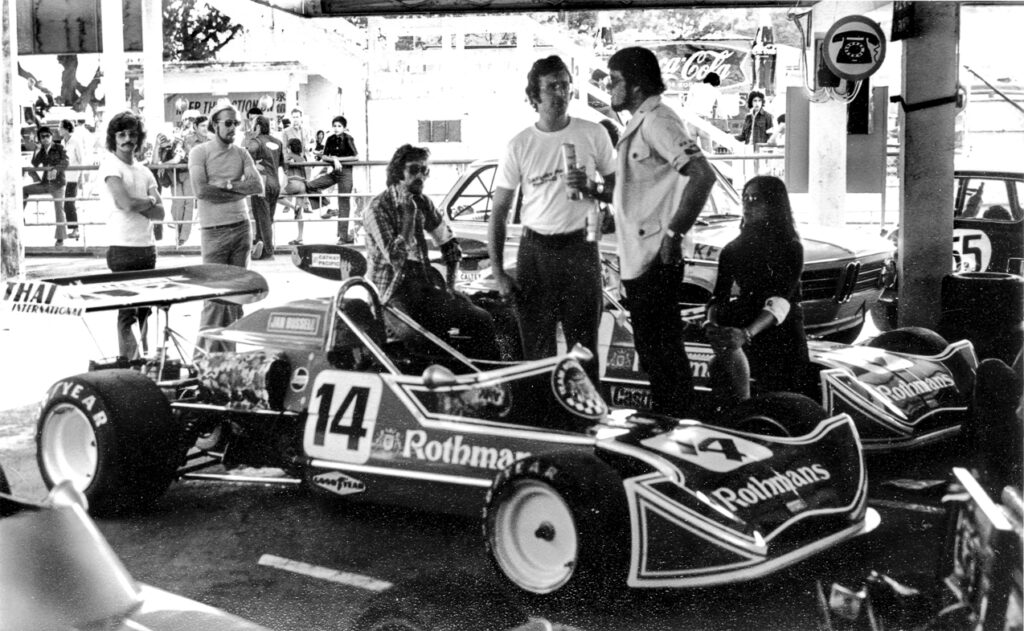
Malaysian Team Rothmans March car 73B (#14) and 732/712M (#9) in Macau, November 1973.
HORROR VACUI
While much has been written about vintage racing in Malaysia and Singapore, there are still large pockets of motor racing history that have been neglected by the local experts, particularly in the area of the open-wheelers that were raced in the Far East from the 1960s to the early 1980s.
To a certain degree, the Brabhams, Chevrons, Coopers, Lolas and Lotus were addressed in articles that appeared in Rewind Magazine. But one marque has posed the researcher with a number of difficulties.
This article hopes to address the dearth in March-specific content.1 March’s Formula One cars are well documented but it was the bread and butter business of customer cars in the lower formulas – Formula 3, Formula 2, Formula Atlantic, Formula Ford, and even Can-Am – that sustained the company.
MONEY MONEY
The focus of this article is strictly on the March racing cars that resided in South East Asia from 1972 until the last races of the Formula Atlantic/Pacific series in 1983. Upgrades and facelifts were the name of the game in motor racing – especially if the fundamental tub and mechanicals were good (not just condition but also design). This has of course made it difficult to establish the origins of a particular car, one of the main reasons researchers tend to avoid the subject altogether.
Racing was and is expensive and even though those who raced often had the means, buying new every season wasn’t the norm. Upgrading a March 712 to a 73B then to a 752/75B [see Appendix 1 – TUBS OF MARCH] was a lot less expensive than buying a new March and the savings could go towards a new or rebuilt engine, an upgrade to fuel injection, new tyres, perhaps even a crew of more than one!
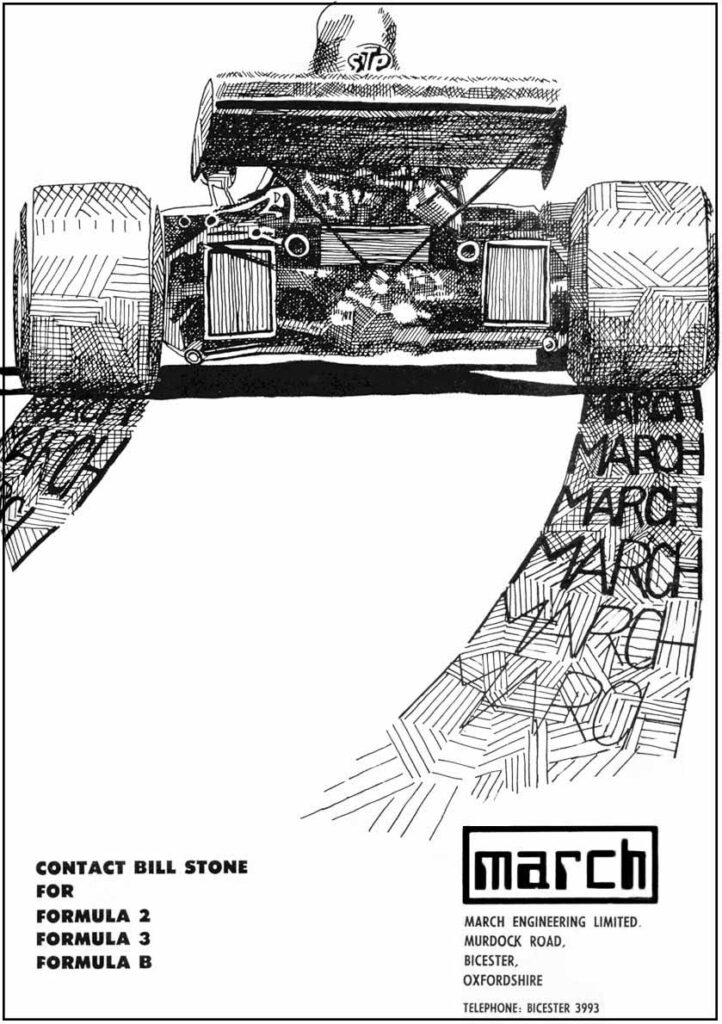
March was the new kid on the block in 1971 and instantly made its mark in Formula 1 as well as Formula 2, 3 and Atlantic. This was an Autosport Magazine advert from 1971.
NEW PLAYER
Swede Ronnie Peterson made his Formula 1 debut in a March 701 run by the Antique Automobiles Racing Team in 1970. He became a full works driver for March the following year and, aside from Formula 1, he was entered in March’s latest Formula 2 car, the 712M. In chassis #7 (with a Cosworth FVA) he won the 1971 European Formula 2 Championship.
His final race in the 1971 Formula 2 championships was at the Gran Premio di Roma at Vallelunga on 10 October 1971, a race he won, beating Dieter Quester (March 712M-14 BMW M12/2) and Carlos Reutemann (Brabham BT36-6 Cosworth FVA). The season belonged to Ronnie Peterson and the March 712M-7.
Following the European Formula 2 races, car and driver were in in Brazil for the four-race Torneio International de Formula 2 do Brasil between 31 October 1971 (Interlagos) and 21 November 1971 (Autódromo Oscar Cabalén, Cordoba). Here chassis #7 wasn’t as successful as it had been in Europe.
For the 1972 season, Peterson was offered the newer 722 (chassis #17, 1,927cc Cosworth BDF motor), sponsored by the STP March Engineering works.2
At the end of the Brazilian races in November, 712M-7 was sent back to the March factory at Murdock Road, Launton Road Industrial Estate in Bicester. Orders were being taken for the 1972 Formula 2 car, the 722, so the works 712s were put up for sale.
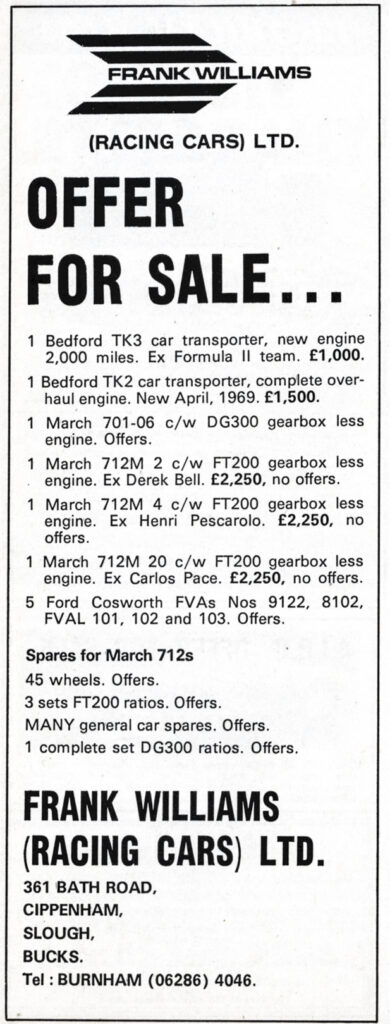
A Frank Williams (Racing Cars) advert for four March single-seaters appeared in Autosport’s 11 December 1971 edition.
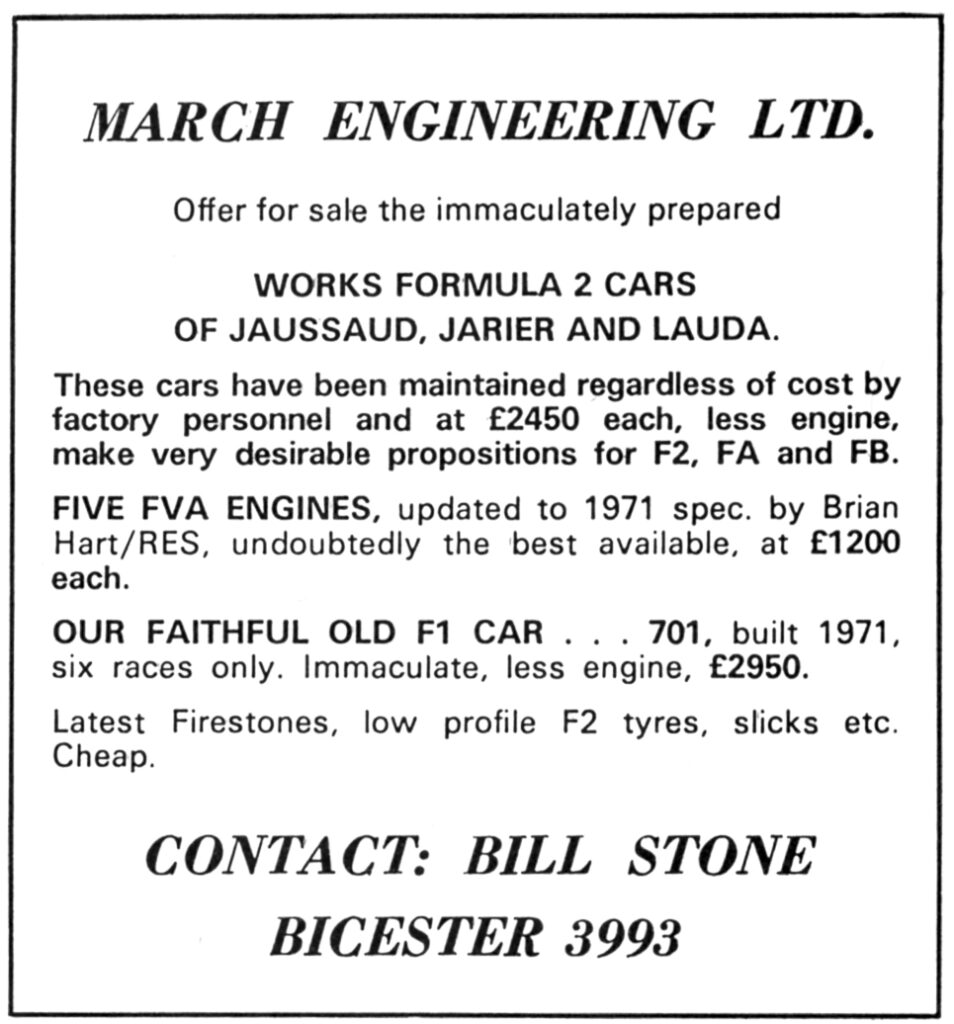
An advert for March works cars for sale in Autosport of 21 October 1971.
Meanwhile, out in the former colonies, disposal incomes were low and sponsorship dosh and motor racing were still in their infancy. The top Asian drivers (there were exceptions – John Macdonald and Albert Poon from Hong Kong had found the funding to buy new cars in the 1970s) tended to gravitate towards the second hand market.
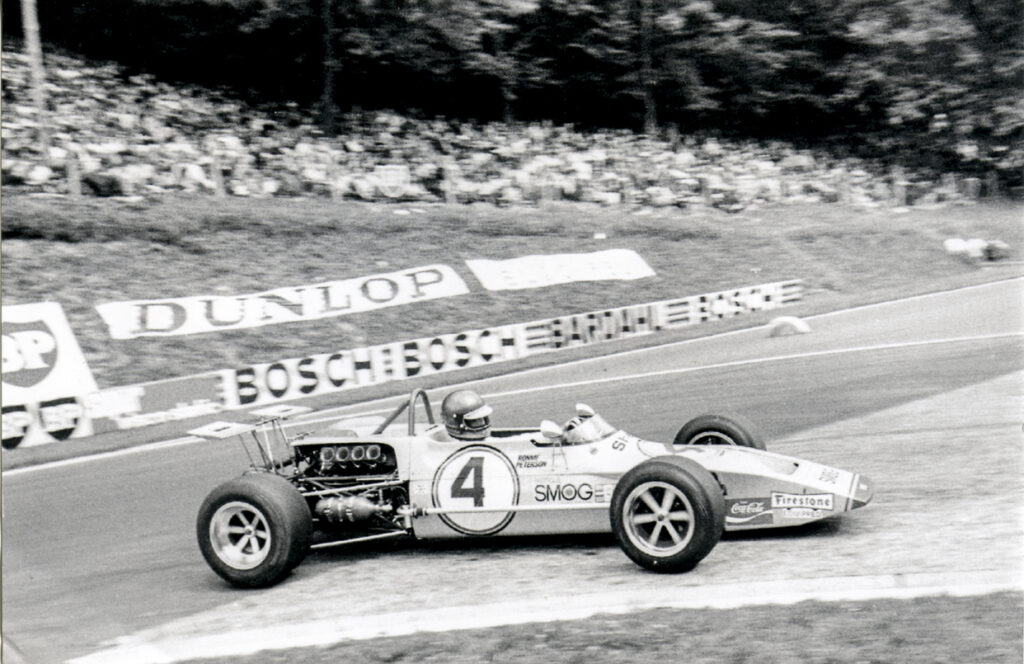
Ronnie Peterson on his way to another win the 1971 Formula 2 Championship in his March 712M – Rouen 27 June 1971.
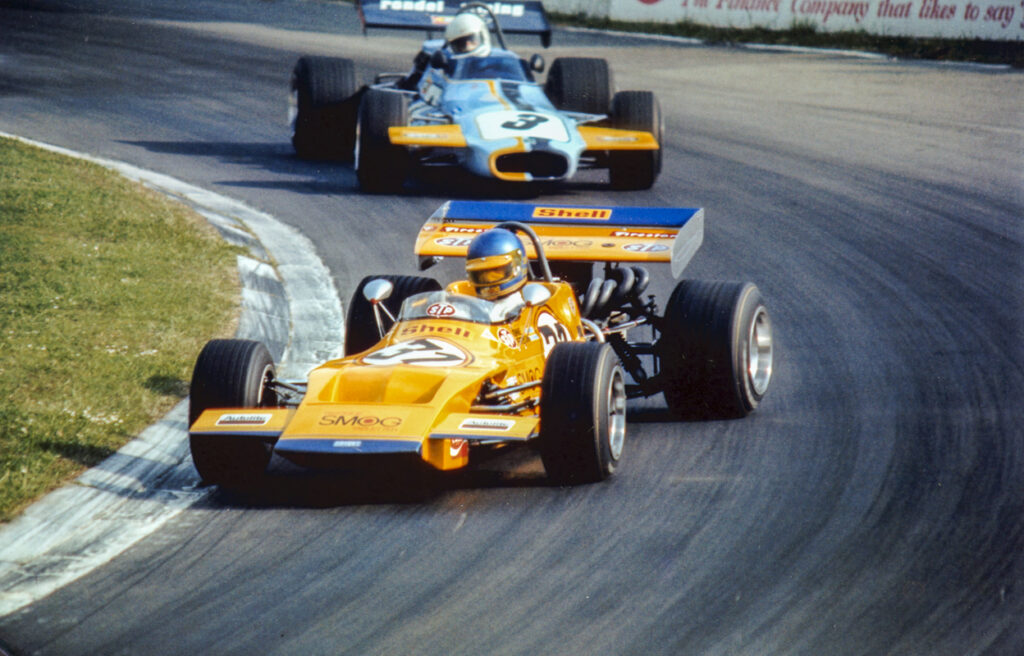
The March 712M in action at the 31 May 1971 Crystal Palace Formula 2 race. Ronnie Peterson finished in third place.
OLD STOCK
Of course there was no lack of new choices from constructors such as Brabham, Lotus, Palliser and of course March, but in 1971, the industry was at a crossroad. Brabham had a new owner and their latest Formula 2/Atlantic car was still built around a spaceframe chassis (the BT40 only arrived in 1973); Lotus no longer made cars for the lower formula so all one had was the 69 and Formula Fords; Palliser weren’t well known; GRD were new; and March had this successful 712 Formula 2 car.
What the enthusiast in Malaysia, Singapore and Hong Kong had, by way of second hand stock, would have come from the racing teams clearing the previous season’s works cars. Or from car dealers who had the odd race car on their forecourt. Adverts from Rondel Racing, Williams Racing etc., would have appealed to the Asia-based driver and many a car came from Rondel, Williams, and even Fred Opert (in the mid-1970s).
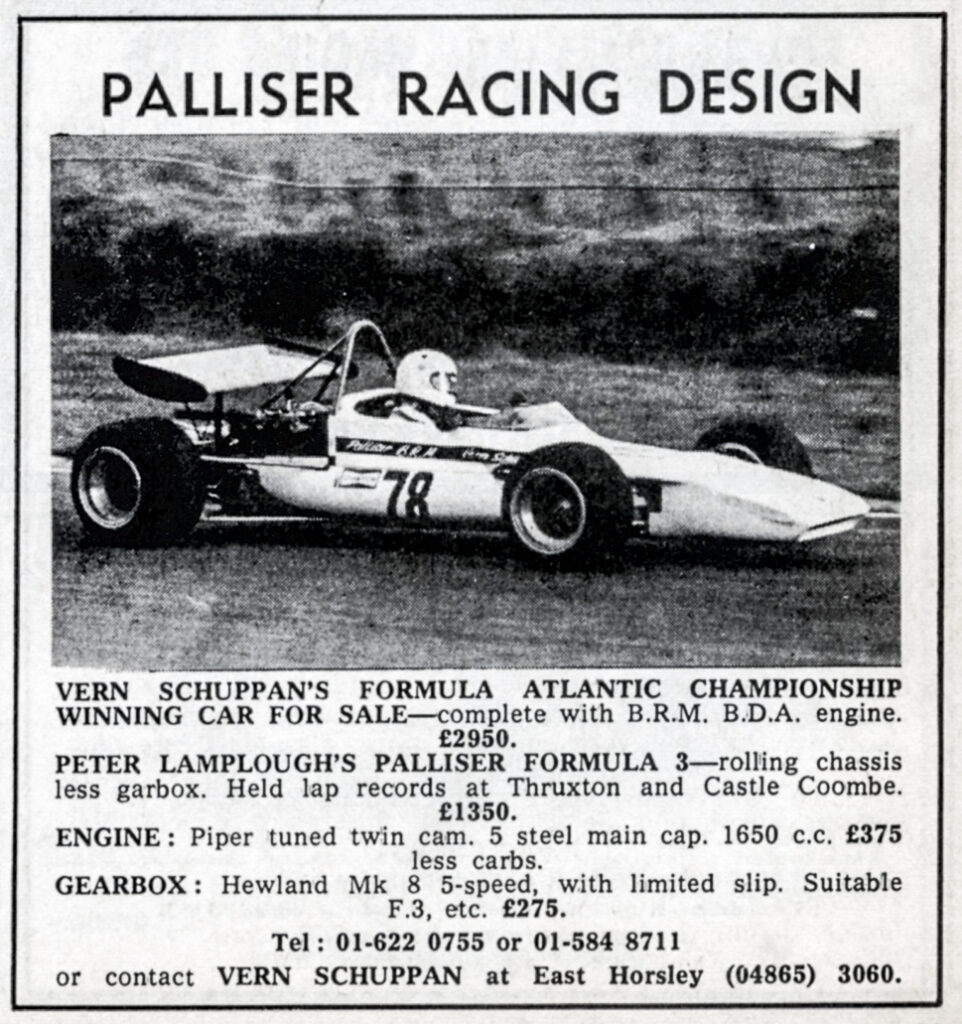
Vern Schuppan’s Palliser WDB4 BRM BDA was advertised in Autosport’s 25 November 1971 edition. Schuppan’s WDB3 (sold to Henkie Iriawan as WDB4/1) was already in Singapore by April 1971.
NEW KID
March Engineering was in fact a very new outfit. The success of its Formula 1 and Formula 2 monocoques in 1971 received a large amount of coverage in the motoring media (especially in Autosport and Motor Sport, the two leading English language motor racing magazines). Motoring journalist Simon Taylor wrote a glowing report in Autosport’s 4 November 1971 edition titled “Quick March!” following an opportunity to test Ronnie Peterson’s Formula 1 March 711 (the car that took the Swede to a second place World Championship finish), as well as the 1972 722 and 723 models.
Taylor wrote: “Robin Herd’s 1970 designs were criticised for being conservative and rather unsophisticated, but these complaints were answered for 1971…Herd came up with monocoque Formula 2 and monocoque and spaceframe Formula 3 chassis which were radically improved and refined. Hundreds of testing laps, mainly with Ronnie Peterson at the wheel, were logged at Silverstone on both types well before the new season got under way, and March were rewarded with large orders from privateers and established teams.”
As alluded to earlier, Peterson wrapped up the European Formula 2 Championship in the 712M3. 1972 would mean a drive in March Engineering’s newest 722 model, leaving the 712M redundant (and for sale) once the Brazilian races were over4.
This was timely, because in October 1971, March’s Bill Stone5 was globetrotting around on a big sales push for March Engineering. There were a number of developments that would affect the course of racing in the Far East and March were in the right space to capitalise on this, hence Stone’s visit to the Far East.
Stone enthused about his visit to the Far East and was quoted as saying that he was confident that “Singapore will become the ‘Mecca’ of motor racing in the Pacific region…”6 His comments followed on the heels of the announcement of the proposed Western Pacific Motor Racing Championships [see SMOKE GETS INTO YOUR EYES].
On his visit to Singapore in October 1971, Stone met with the big wigs of the Singapore Motor Sport Club as well as with drivers such as Sonny Rajah. In 1971 there could hardly have been more than 3-4 graded drivers capable of hopping into a Formula 2 car in Singapore, Malaysia, Hong Kong, Manila or Jakarta. There were even less who had any sort of racing school experiences. In the Malay Peninsula exceptions were Sonny Rajah and Anne Wong, both of whom attended the Motor Racing Stables racing school at Brands Hatch in 1970. Following on were Indonesians Robert Silitonga and Chepot Hanny Wiano. The Indonesians however went to the Jim Russell Racing School instead.
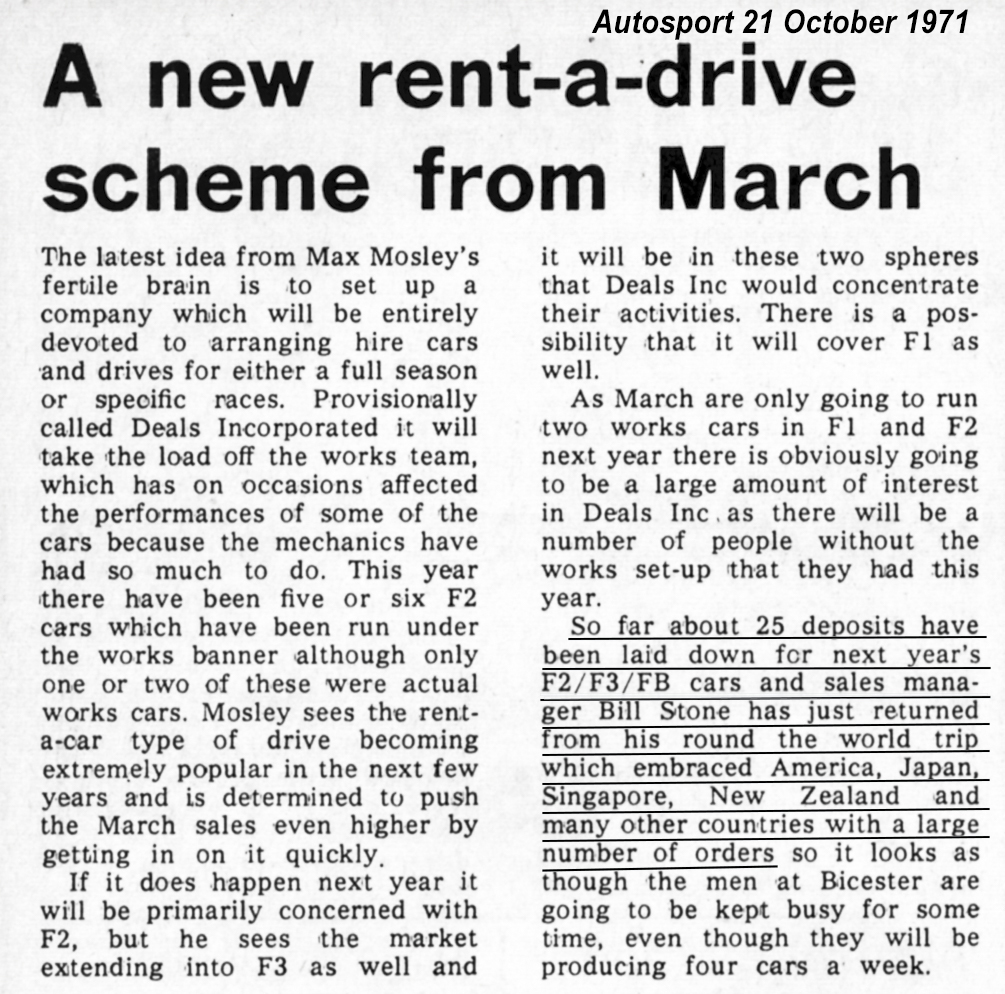
Bill Stone’s marketing trip featured in Autosport’s 21 October 1971 edition. It gives an approximate time of his trip to South East Asia, a visit that would result in the Ronnie Peterson March 712M going to Malaysian Sonny Rajah, thanks to support from Rothmans of Pall Mall (Malaysia).
Three things were working in favour of the lower Formulae constructors such as March Engineering.
1 – Pacific & Far East Racing Championships [see SMOKE GETS IN YOUR EYES – the story of the Western Pacific Motor Racing Championships]
2 – Max Mosley’s “fertile brain” and his rent-a-car idea.
3 – Availability of constructors as well as engines to choose from – the proliferation of manufacturers in Formula 2, Formula Atlantic, Formula 3 and Formula Ford. The 1971 (11 November 1971 edition) listed 23 UK-based constructors that built single-seaters for the various Formulae – from F1 to Super Vee. The list did not include the smaller companies. Add to that the proliferation of engine tuners – from Alan Smith to Brian Hart, BRM, Broadspeed, Cosworth, Felday, Novamotor, RES (Race Engine Services), Vegantune…one had an endless list to choose from.
The downside was that regulations in Asia were somewhat fluid in the Formula Libre environment that prevailed up to 1970. Come 1971, new rules (where there were almost none previously) applied for the Asian Grand Prix grid.
FIRST COME
The first March that we are introduced to in South East Asia is the 712M7, March Engineering’s first monocoque construction that really took Formula 2 by storm in 1971.
Locals were introduced to the 712M when the Malay Berita Harian newspaper (Saturday, 11 December 1971) and Straits Times (same date, pg. 28) broke the story that young rising star Sonny Rajah was heading to UK the following week to finalise purchase of the canary yellow Ronnie Peterson car and undergo a winter training program under Peterson.
This was big news because the crop of single-seater racing drivers from Singapore and Malaysia had whittled down to just a couple of names – Chong Boon Seng and Lionel Chan8, neither of whom were professional or seeking to become professional. Chong had a Lotus 41 and was soon to acquire a Brabham BT30 while Lionel Chan had a pair of older cars, the ex-Rodney Seow Merlyn Mk5/7 [See LUNCH WITH CHAMPIONS: RODNEY SEOW] and a mid-60s Brabham Twin Cam.
23-year-old Sonny Rajah, on the other hand, was new to the single-seater scene in 1971 and prepared to take a huge leap of faith into single-seater racing. Going from a sub-one-minute blast up a hill in a Lotus Europa at the Gap Hill Climb to racing a Formula 3 car was no walk in the park, though he had undergone a two-month course at Motor Racing Stables at Brands Hatch in 1970. His first single-seater purchase was a Lotus 59/69, said to have been the James Hunt car from the 1970 UK Formula 3 season.
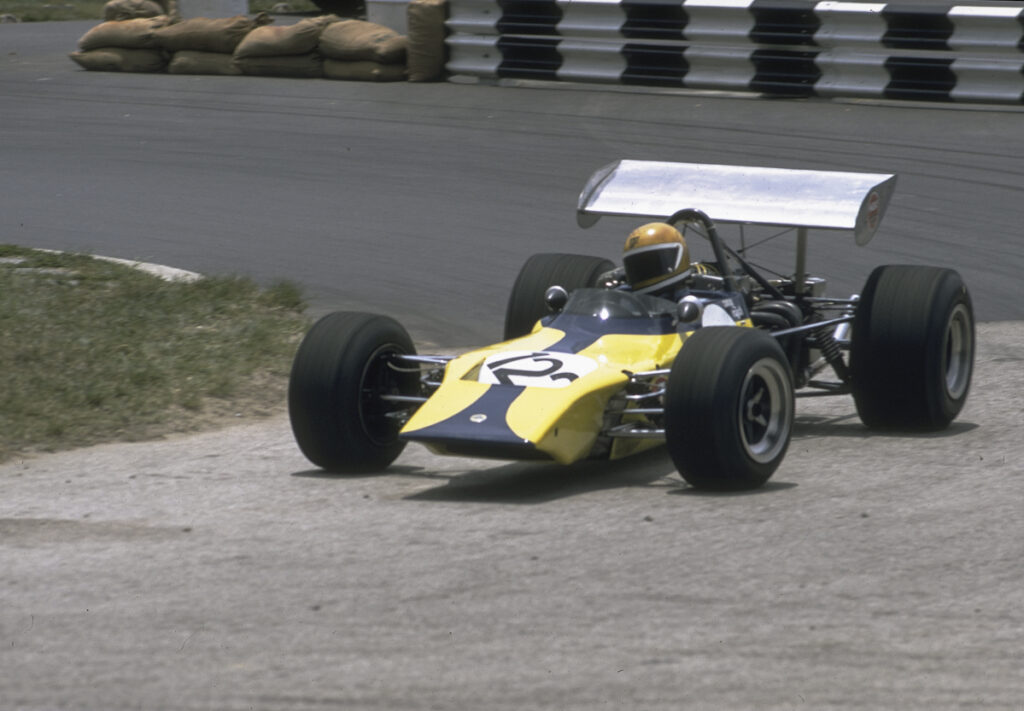
Sonny Rajah in his Team Aries Lotus 69 at the 1971 Singapore Grand Prix.
Sonny had immense natural talent, according to both Hong Kong’s John Macdonald and Kiwi Graeme Lawrence. Sonny and his ex-James Hunt Lotus 59/69 are well documented in the official Singapore Grand Prix history9 and by the local Lotus experts so there’s little need to duplicate their efforts here except to include a timeline of the Lotus 59/69 in Asia10
MARCHING ALONG
But I digress. Following Sonny’s disastrous 1971 Macau Grand Prix in his Lotus 59/69, the Malaysian racer took the decision to acquire something newer, this time with financial support from Rothmans of Pall Mall (Malaysia) and freight courtesy of Malaysia-Singapore Airlines (MSA) 11.
In late 1971, Sonny would have had numerous options for the 1972 racing season, given the prospect of Rothmans of Pall Mall (Malaysia) backing. One such option was to stay with Lotus and acquire the ex-Jochen Rindt Formula 2 Lotus 69 (with Cosworth FVA and FT200 gearbox) which Brian Classic had for sale. Complete with spares, it was offered at £3,195. There was a catch – the 1972 regulations for the Far East season stipulated a two-valve per cylinder 1600cc engine. The FVA had a four-valve per cylinder. Engines weren’t cheap! Sonny already had a fleeting look at buying a new Brabhams12 (BT35 or 36) – but that was back in late 1970, before the Lotus was purchased.
A new F2 less engine cost £3,600 in 1971. GRD might have been one other option – an F2, with FG400 transmission, less engine, would have cost £3,250. A new Formula 2 March 722, with everything but the motor, would have cost £3,625.
There were pre-loved options – off the shelf were the cars from Frank Williams (Racing Cars), for example. In December 1971 Williams offered four March racing cars – a 701, and three 712Ms. The 712Ms came with FT200 transmissions, the ex-Derek Bell, ex-Henri Pescarolo, and the ex-Carlos Pace cars. The Formula 2 cars were offered at £2,250 each, complete with the FT200 box but less engine. It was widely known that while March had built approximately 20 712s, by mid-season there were probably 30 monocoques out there, which meant a healthy spares situation.
The local papers were abuzz with the news. “Racing ‘ace’ Sonny to train in Britain,” caught the public’s attention as did “Ambitious Rajah takes over a world beater’s machine.” The March 712M cost something in the region of S$35,000 (~£6,700), a bit more expensive than buying a brand new BMW 520 locally.
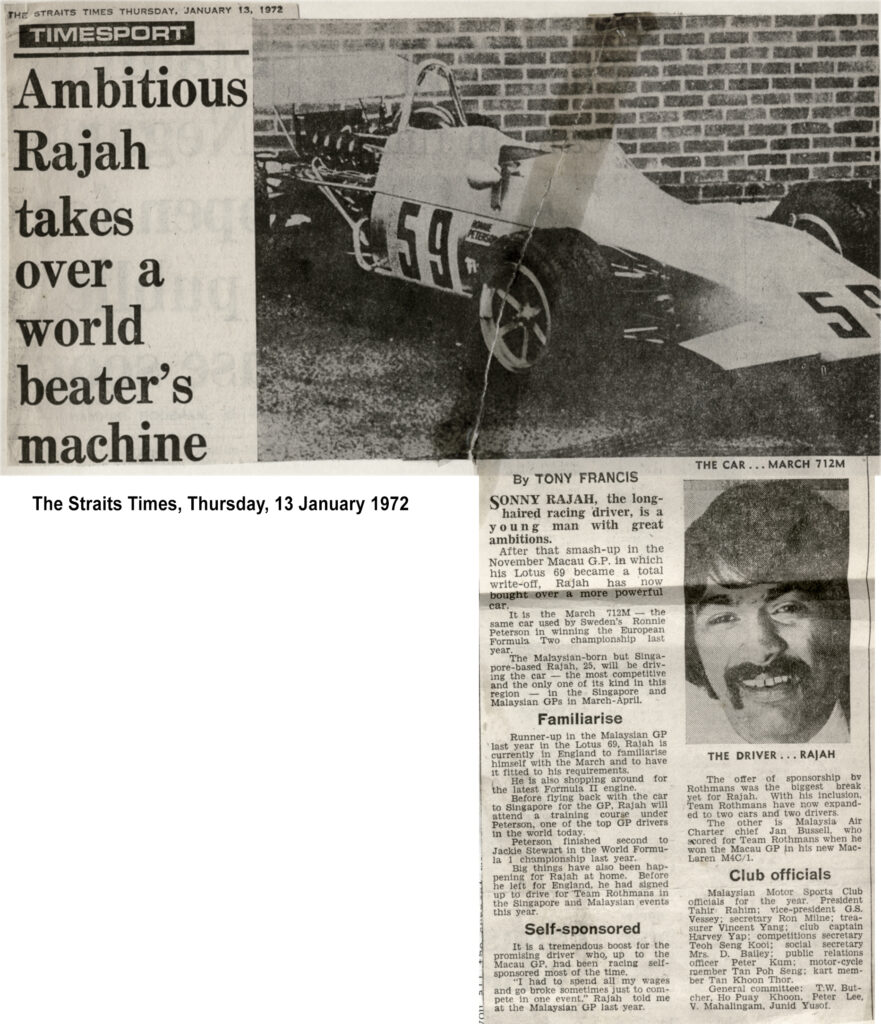
Singapore’s Straits Times ran a story on Sonny Rajah and his latest acquisition in its Thursday, 13 January 1972 edition.
Sonny’s March arrived via MSA freight on 18 January 1972, in knock-down form (the only way it could fit on a pallet and sent by airplane). The bodywork was still in its yellow paint scheme that Ronnie Peterson had raced it. We don’t know if the bodywork had been altered but the wing mirrors were different.
To understand how all this came about, we have to backtrack to October 1971 when March’s Sales Manager Bill Stone was in Singapore to check out the racing scene in South East Asia. The discussions addressed Sonny Rajah’s racing ambitions but the real reason for the visit was to see if March Engineering could sell more cars in the region. The net had been cast.
March’s racing cars had indeed received a great deal of coverage and as Max Mosley quipped in his Autobiography, “Someone said ‘March’ stood for Much Advertised Racing Car Hoax…”
None of these grand plans would have been possibly without one key participant in the region.
KING SIZE SUPPORT
Recall that the design of the Batu Tiga permanent circuit was by a committee of Malaysian Motor Sports Club13 members led by Chairman John M. Brown14 (who was also the Managing Director of Rothmans of Pall Mall Malaysia). In Singapore, a cigarette advert ban was in force by 1971 but the Rothmans vans were at the paddock with built-in facilities like air-conditioning. Of course the marshals love it.
John E.D. Clinton had assumed John M. Brown’s position as Managing Director of Rothmans’ Malaysian operations at the end of 1968 when 41-year-old Brown was offered the post of MD at Carreras Ltd. Clinton thus became CEO as well as GM of Rothmans Malaysia from January 1969. Clinton had been with Rothmans Malaysia since circa 1964 and was MD/CEO until May 1974 when he was posted to the UK to Carreras Rothmans, the parent company. He continued to remain on the board of Rothmans Malaysia. Brown and Clinton were key to the developments of motor sports in the region. Gerald Vessey, marketing director at Rothamns from 1967 (when Clinton was promoted to be General Manager) was another key member of the Rothmans team. Vessey later succeeded Clinton as CEO of Rothmans Malaysia in May 1974.
So when Jan Bussell obtained Rothmans Malaysia backing in 197115, it was with Vessey as Marketing Director. Vessey was also Vice-President of the Malaysian Motor Sports Club (MMSC)16.
MARCH IN APRIL WIN
Testing the still canary yellow car took place over two weeks at Batu Tiga in February where Sonny broke the lap record with a 1:24.00 lap time. Car and driver showed promise. It was soon painted in Rothmans’ blue in Malaysia – the second Rothmans-backed Malaysian-based driver after Rothmans sponsored Jan Bussell and his McLaren M4C-1 (winning the 1971 Macau Grand Prix!).
The Far East racing season commenced with the Singapore Grand Prix between 29 March-2 April 1972. The March was based at the Woodleigh “Garage”, the home of Ken Evans (whose son Rolf was good friends with Sonny) at Woodleigh Park in Singapore. The car was surrounded by chairs, coffee tables and spare tyres, in the lounge of “an equally car crazy wife and family.” 17 While Ken had looked after Sonny’s Lotus 59/69, the March was handled by Barry Pilsworth from March, who was also camping out at Woodleigh Garage.
It must have been a busy period for the Evans clan as Woodleigh Garage was pretty much an open house for the vintage car racers from upstate. Plus Ken was also entered in the Sports & GT race in his aged Lola Mk1 Climax (ex-Chan Lye Choon). Sonny finished the Grand Prix in 5th place, one of just two March cars entered in Singapore.
EASTERN ESCAPADE
It was inevitable that UK-based Australian Vern Schuppan would meet Teddy Yip when the maverick Hong Kong businessman and successful Macau casino operator was looking to establish a race team. The important introduction took place in Singapore in 1972. Teddy bought Vern’s March 722-40 and extended him an invitation to race in Macau that year.
After winning the Formula Atlantic series in 1971, Vern acquired a new March 722 for the 1972 season. He had attracted attention to merit an invitation to race in Singapore again, this time with sponsorship from Malaysia-Singapore Airlines (MSA) though the official Grand Prix program listed Vern’s #129 entry as a Palliser.
It almost went terribly wrong during practice ahead of the Grand Prix. A suspension rear-end failure sent the car careering off into the jungle at The Snakes and relegated him to the back of the grid for the race. “Luckily, and with the help of one of the little local garages, we were able to repair the car and I took my place at the back of the grid,” he said. It was hastily rebuilt but Vern managed to finish an astonishing second, “Right behind one of my great heroes, Max Stewart,” he told this writer. Stewart won, but the Formula 1 hopeful won the hearts of the fans.
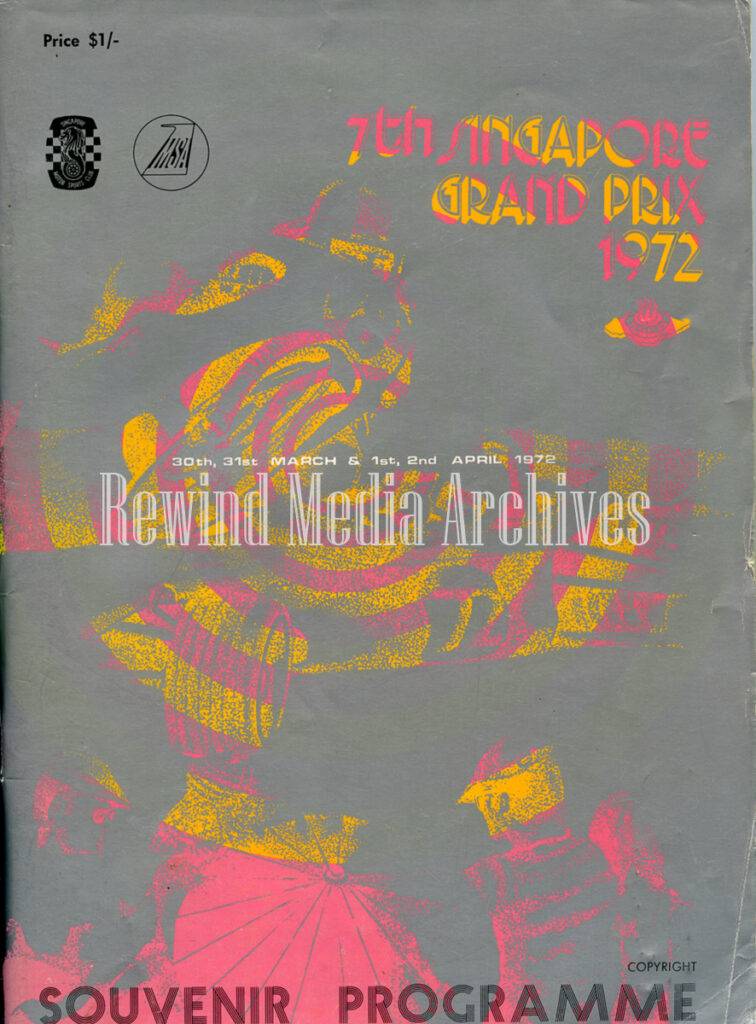
The program cover for the 1972 Singapore Grand Prix. [See RMA Program Library – Singapore]
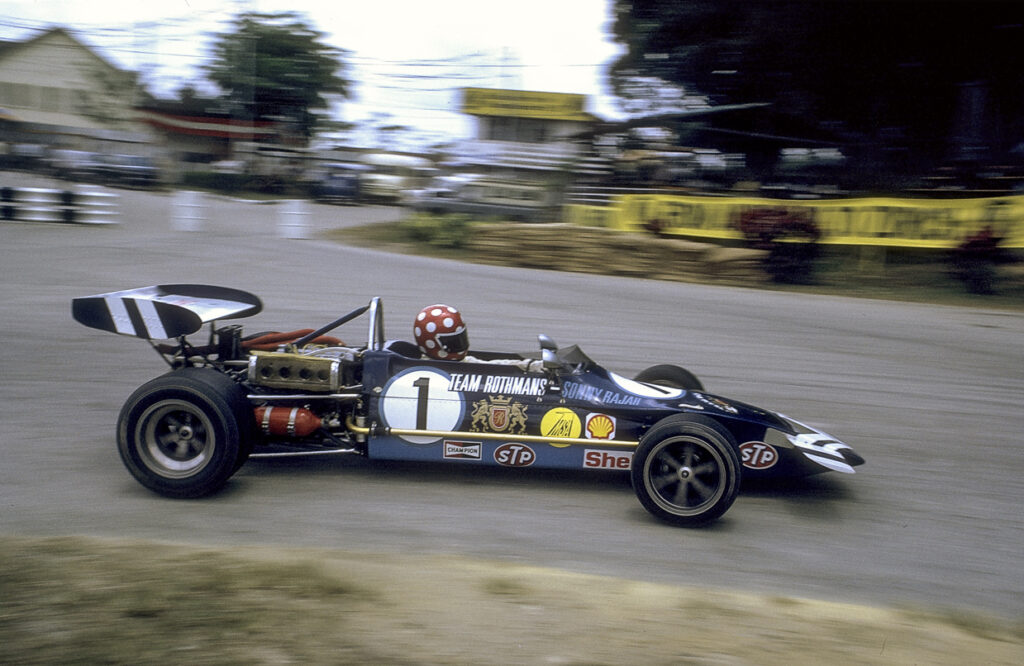
Sonny Rajah in his racing billboard as it powers out of Circus Hairpin towards The Snakes during the 1972 Singapore Grand Prix. He finished fifth.
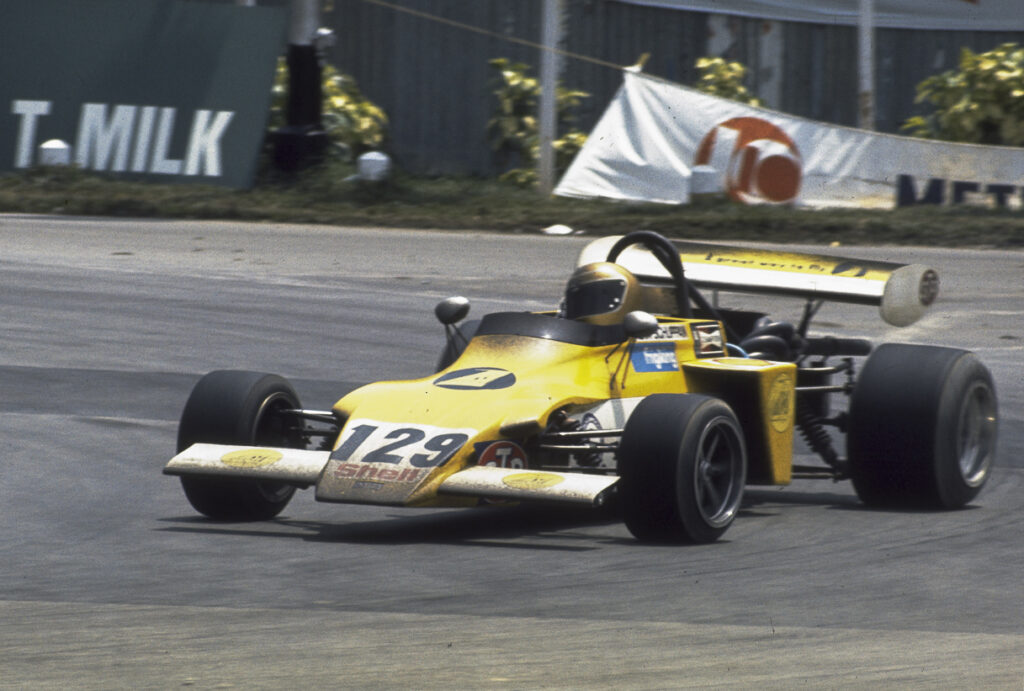
Australian Vern Schuppan had MSA backing for his March 722 entry in the 1972 Singapore Grand Prix. The 722 carried its original specification bodywork with side-mounted radiators. Vern clawed his way from the back of the grid to finish second in the Grand Prix!
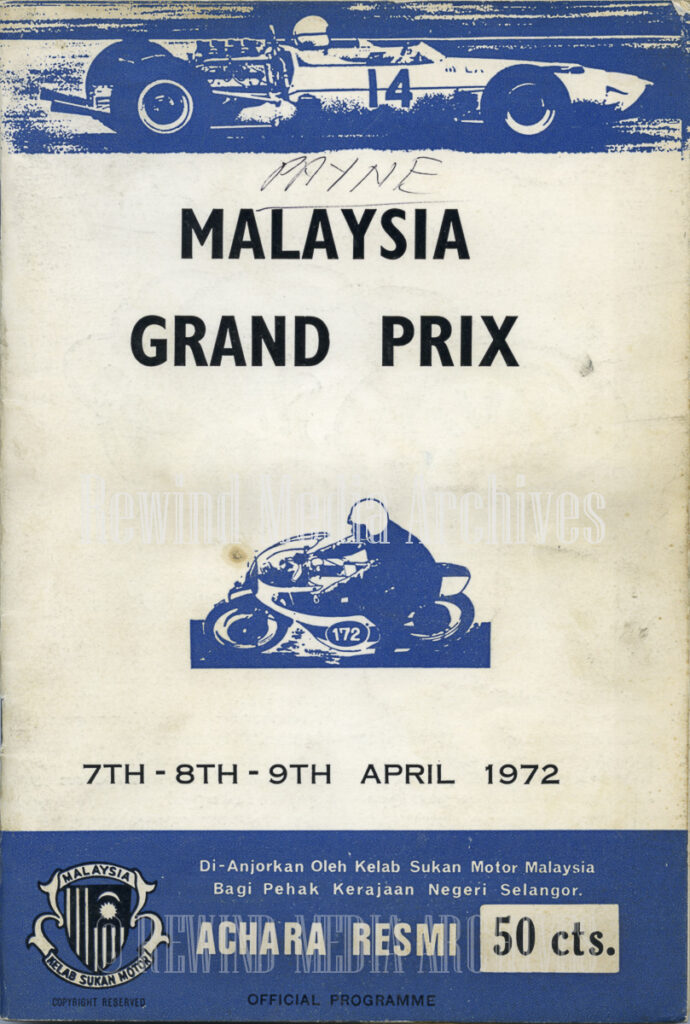
Teams and drivers headed up to Shah Alam for the Malaysian Grand Prix on 9 April 1972 and Sonny Rajah finally wrote his name into the record books with a fantastic start-to-finish victory in the Grand Prix.
Everyone was up at Batu Tiga the following week for the Malaysia Grand Prix on 9 April and here Sonny made his mark by beating a strong international cast of entrants. Not only did the 712M win, Sonny set FTD at 1:23.0. Second was Kiwi Ken Smith (Lotus 69B); third was Australian Vern Schuppan (March 722); fourth was Australian Kevin Bartlett (Brabham BT30); fifth was Australian Tony Stewart (Elfin 600); sixth was Malaysian Percy Chan (Brabham BT15); seventh was Japanese Rikki Okhubo (Brabham BT38). Kiwi Dave Schollum was next, first of the Formula Fords (Elden). Jan Bussell was a lowly eleventh in his Palliser WBD3, his McLaren M4C having been torched to the ground at the Singapore Grand Prix the week before.
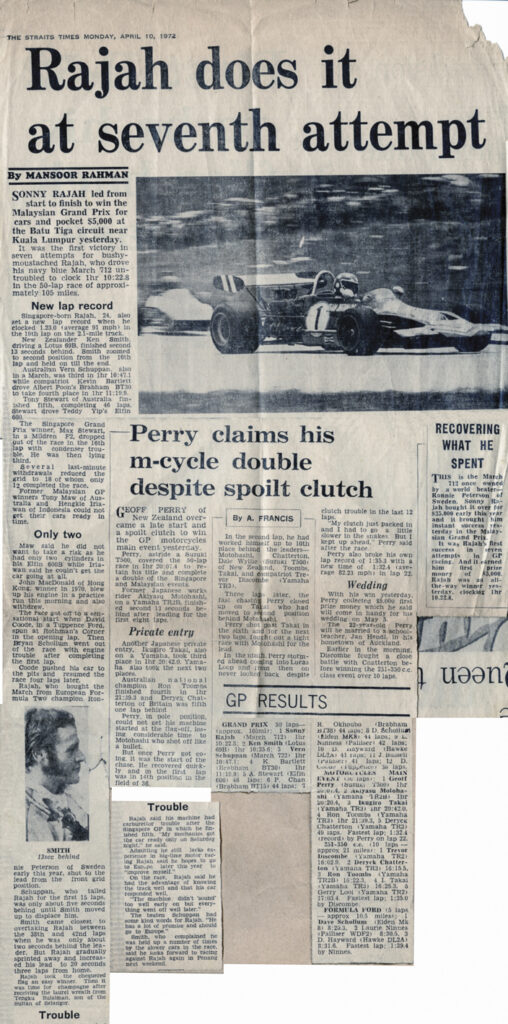
Singapore’s Straits Times featured Sonny’s Grand Prix victory in its Monday 10 April 1972 edition.
The March 712M was now on a roll and Penang beckoned 15-16 April 1972. Sonny was quietly confident but Penang wasn’t Shah Alam and set up for the street circuit was crucial. Still, the race got off to a great start for the Malaysian. He was leading after 12 laps and then it happened. He hit an oil patch and that was it. Ken Smith went on to win, Albert Poon finished second and KL-based Tony Maw was third.
WETTING THE FEET
The 712M was bundled off and sent back to UK with Sonny intending to participate in the 1972 British Formula Atlantic series.
Sonny flew to the UK on 11 June 1972 but missed the Silverstone round. The #48 March also missed the Brands Hatch round on 25 June but was ready for Snetterton’s 15 lap race on 9 July where the Malaysian finished seventh after qualifying twelth. It hadn’t been plain sailing for Sonny in the UK. He was allowed to race only a few races due to a mix up in his race entry, through no fault of his. At Brands Hatch 30 July, he wasn’t allowed to race in the Formula Atlantics race but was allowed to race in the Formula Libre race (20 cars) where he finished second, even with a flat tyre. At Croft on 6 August he finished on the podium (third) of the Formula Atlantic race, having qualified in seventh.
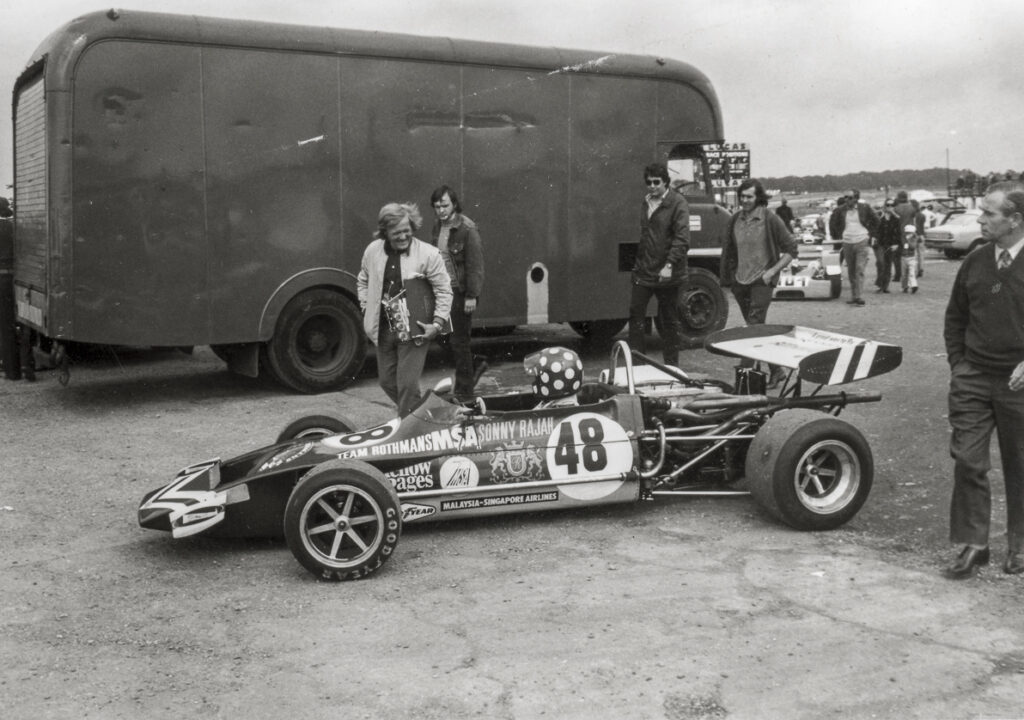
Malaysian Sonny Rajah had his 712M entered for the 9 July 1972 Snetterton round of the 1972 Yellow Pages Formula Atlantic Championship race. He finished seventh. Jan Bussell, another of the Rothmans-sponsored drivers from Malaysia, was with Sonny in the UK.
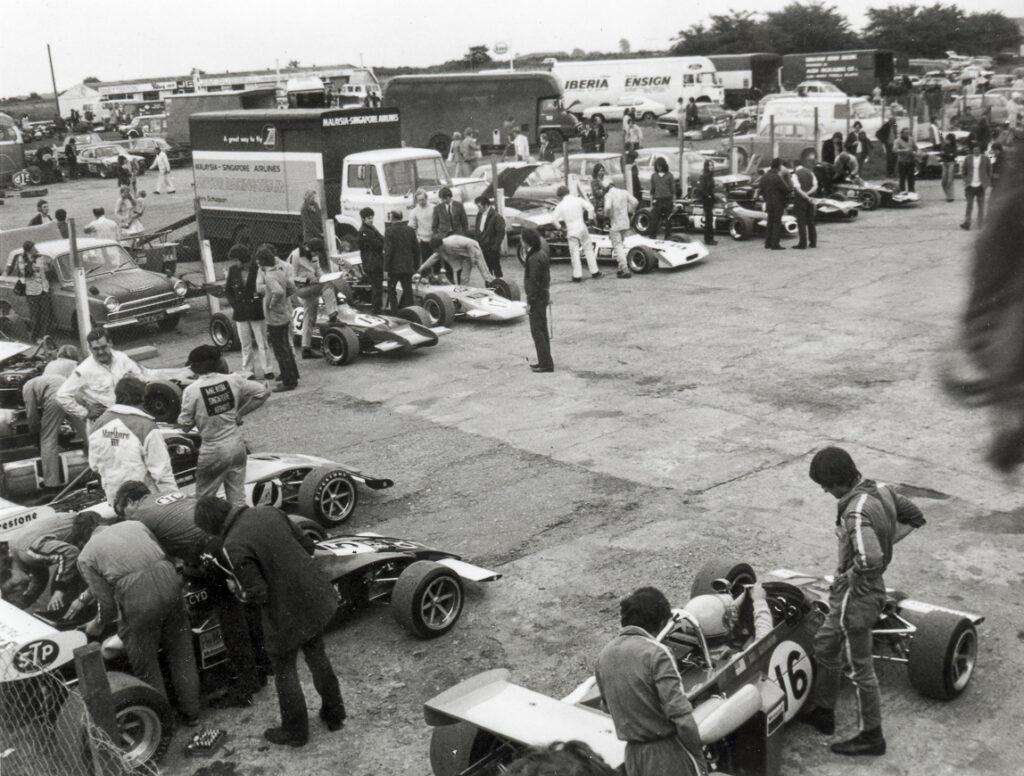
An interesting photo from the 1972 Atlantic Series showing Vern Schuppan’s Malaysia-Singapore Airlines race truck and the wide nose 722 March in front of it. Sonny’s 712M is the third car from the bottom right.
WINTER PUSH
And that was it for the Atlantic foray for Sonny Rajah and his March 712M. Or was it? The pockets may have been dry but the 712M was still airlifted home on Sunday 13 August 1972 for the Selangor Grand Prix on 9-10 September.
Back home, the car was quick straight off the bat. Sonny’s practice times at Batu Tiga at the end of August were good, and he set a new best of 1:22, a second faster than his FTD when he won in April. Could Sonny do it again on 10 September?
He almost did. Once again he led a race only to hit trouble – this time it was a loose distributor cable that caused him fail with just seven laps remaining, though he is registered as finishing sixth. The consolation was that he set FTD at 1:27.4. There were just nine starters in the race in which Borneo-based helicopter pilot Harvey Simon won in his Elfin 600SA (chassis 7108).
MACAU INITIATION
The season was far from done. There was still the Macau Grand Prix on 26 November and a Yellow Pages Atlantic series race at Brands Hatch on Boxing Day. And if he could make it back home in time, there was the Malaysian National Open Championships on 30-31 December 1972, which featured a 50-lap Grand Prix race (there were no March cars featured). Sonny had a strong Malaysian following and the local auto distributors must have realised that having Sonny in one of their saloon cars would be worth the adspend.
The 1972 Macau Grand Prix was a two weekend affair with the ACP Trophy for saloons, a junior motorcycle race, and the Guia 200 (modified saloons) on the first weekend and the Touring Cars, motorcycle Grand Prix and motor car Grand Prix the following weekend.
Sonny, Jan Bussell (Palliser WDB3) and Harvey Simon (Elfin 600SA) had come over from Malaysia. There was one newcomer to Macau – Australian Vern Schuppan (soon to be a BRM Formula 1 driver). Vern, entered in a Singapore Airlines-sponsored March 722 that now belonged to Hong Kong tycoon Teddy Yip, instantly made his mark, slashing the lap record set by Dieter Quester in 1970 by three seconds! Vern was on pole and a whole nine seconds faster than second place Albert Poon in a Brabham BT30. Sonny started on row two with Bussell and Simon on row three.
It was not the auspicious start for Teddy Yip’s newest acquisition, nor for his driver Vern Schuppan. “I was on pole position and burnt the clutch off the line,” Vern recalled. Things could only improve. Teddy’s Theodore Racing Team would soon play a big part in the Australian’s racing aspirations.
Sonny however finished a very creditable third, under a minute behind eventual winner John Macdonald in his #11 Rondel Brabham BT36 but Vern, clearly the fastest out there, had clutch issues and DNF-ed. It was the first time March cars had raced in Macau and pole, a new track record and a podium finish wasn’t too bad at all.
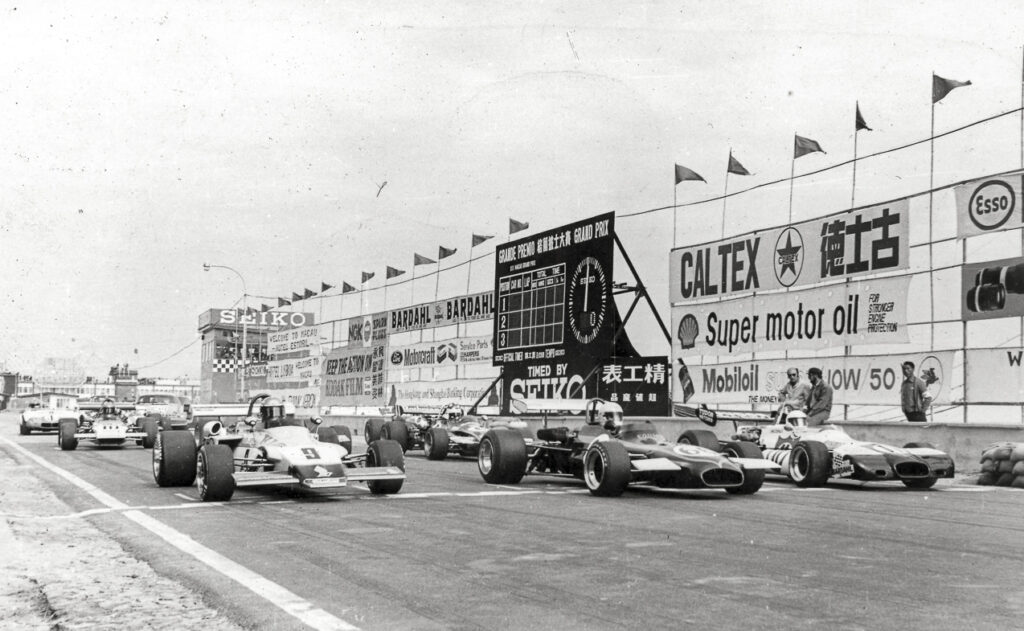
The start of the 1972 Macau Grand Prix. Vern Schuppan made his debut and was on pole in his Singapore Airlines #9 March 722-40. Sonny Rajah and his #6 March 712M can be seen behind the #66 Brabham BT30 of Albert Poon. Sonny finished a very creditable third, under a minute behind eventual winner John Macdonald in his #11 Rondel Brabham BT36 (right of photo).
BOXING DAY MARCH
Following Macau, Sonny Rajah’s 712M was soon back at Bicester, this time for a major upgrade and facelift. He was in the UK over Christmas and what better way to finish off the year than race at Brands Hatch on Boxing Day. There was a catch – he needed a car.
Enter Tate Of Leeds with a March 712M!18
The #48 Tate of Leeds car was the ex-Wilson Fittipaldi March 712M-1719 but it appears Rajah used his own RES-built BDA motor for this event. It was a one-off lease for Sonny and he finished seventh for this Yellow Pages Atlantic race.
MARCH FACELIFT
Back in the UK in the spring of 1973, Sonny Rajah entered the 1973 Yellow Pages International Formula Atlantic Championship race at Brands Hatch on 18 March 1973. The entry was for his 712M but it turns out he DNA-ed for the race. At Mallory Park on 1 April, his entry was for the Scott Gormley-entered March 732B with Ford BDA Hart engine. Sonny missed this race as well. Work on the 712M was still on going at the factory and it was looking increasingly likely that Sonny would not have the car before the season was over.
This was the third Formula Atlantic season, which up to then, was still a predominantly British affair. For 1973 there were two championships – one sponsored by Thompson’s Yellow Pages, the second the BP Championship, centred around club meetings with the Atlantics as feature race of the afternoon, hence the significantly larger number of events (18 races versus just 6 for the Yellow Pages Championship).
1973 FORMULA ATLANTICS
The deal to acquire the new 73B was secured on Friday 6 April 1973. The 712M had returned to the March factory for a major refresh but the constructor wasn’t able to deliver the car in time for the start of the 1973 Yellow Pages/BP Championship, nor for the Malaysian/Singapore/Penang Grand Prix in April/May.
There were several mitigating factors and one was March’s lack of funding. At the end of the 1972 F1 season, March Engineering didn’t have a star driver, nor did it have a new car for the 1973 F1 season. Funding was very tight and the company’s F1 program for 1973 was “a low-key affair,” according to Mike Lawrence20. The production car business thus received most of the attention, the priority being the Formula 2 732 cars.
Sonny’s decision to acquire another car was an exasperating experience. He miraculously managed to rustle up enough interest to get some sort of backing and a March 73B was acquired with the help of friend Scott Gormley. The car was immediately packed for delivery to Kuala Lumpur for the 1973 Malaysia (14-15 April) and Singapore Grand Prix (21-22 April).
Sonny Rajah now had a new March 73B21 for the 1973 season which he used in a few of the Yellow Pages International Formula Atlantic Championship 22) as well as three of the BP sponsored 18-race national championship series (BP Formula Atlantic Championship).
JUNGLE MARCH
Sonny was back in Singapore on Tuesday, 10th April. It was touch and go. Would the March 73B arrive in time for the 14-15 March 1973 Malaysian Grand Prix? The car was purchased sans engine and his 1.6-litre Ford BDA RES engine was ineligible for the South East Asian races. In the jungles of South East Asia, you couldn’t simply pick up the phone in Petaling Jaya or 10 Alnwick Road in Singapore (the Rajah home address) and have a Hart Twin Cam delivered over on a Datsun pick-up.
The competition was rather serious about ensuring that Sonny didn’t upstate the foreigners. Graeme Lawrence took his Surtees TS15 out for a few practice runs on the Thursday before the Grand Prix and shaved a second off Sonny’s times set the year before (1:22 vs 1:23). Lawrence expected the times to fall further in qualifying, possibly down to the high 1:20s and low 1:21s. And since Formula 1 driver Vern Schuppan was not entered for the Malaysian Grand Prix, it was game on for Lawrence and the rest.
It appears that Sonny raced it in Malaysia with a Brian Hart Twin Cam motor – which vented its crank during the Grand Prix. A borrowed motor (from Ken Smith – who was entered in the prototype March 722) allowed Sonny to run in Singapore the following weekend. Sonny set third fastest time in practice in Singapore and qualified ninth for the Grand Prix. The battery fell out during the race and he was out on lap 25. The 73B was packed and sent back to the UK.
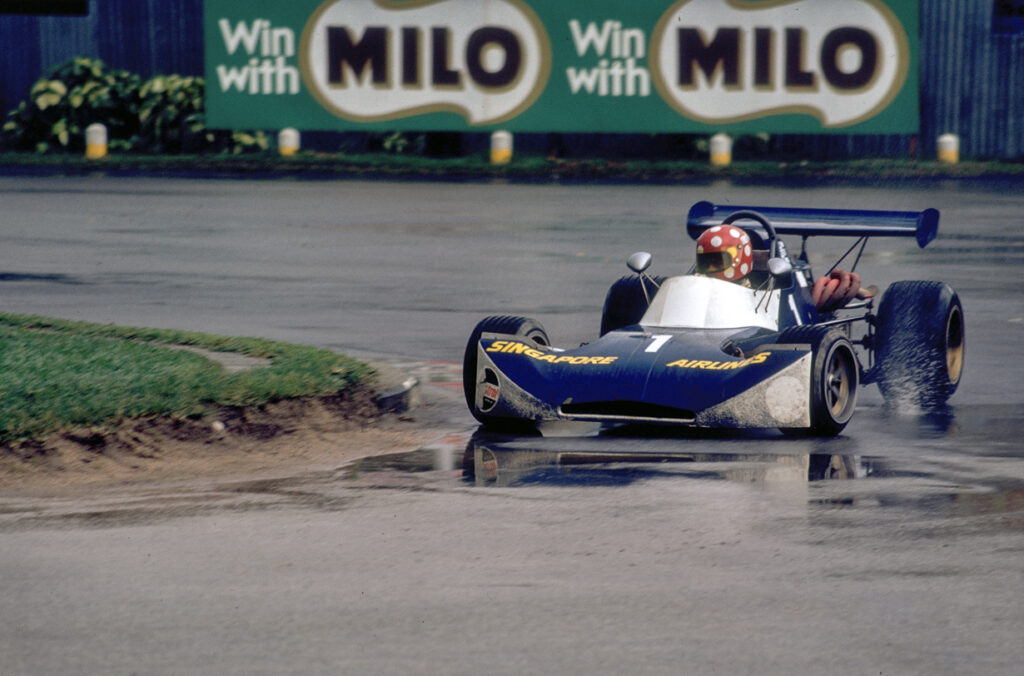
Was Sonny Rajah’s #1 entry his uprated his 712M or the newly acquired 73B Twin Cam Hart for the 1973 Singapore Grand Prix over Easter? The timelines suggest that this was his latest acquisition though the roll hoop, rear wing and wing mirrors differ from the 73B that eventually arrived in Malaysia in August 1973.
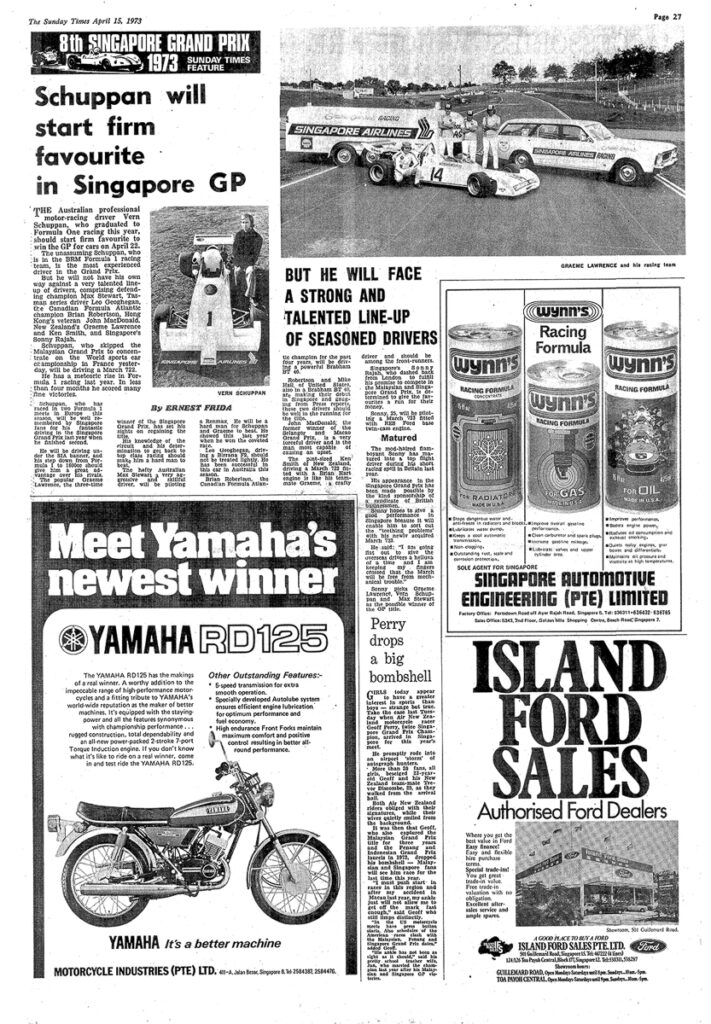
The 1973 Singapore Grand Prix grid consisted of just three March entries – The Singapore Airlines entries of Vern Schuppan in his March 722 23 and Sonny Rajah in his new March 732, and the Air New Zealand entry of Ken Smith in the prototype March 722.
Vern had a hectic schedule – He was entered in the British Formula 2 series, the 1973 Singapore Grand Prix over Easter, the JAF Japanese Grand Prix, and various races across several continents. Vern recalled his third visit to Singapore with relish. As a Formula 1 driver, he was instantly installed by the local media as one of the favourite drivers to win the Grand Prix.
Vern’s trusty March 722 had been upgraded with a new aerodynamic package and wide-track suspension by March Racing’s aerodynamicist, Denis Falconer. It was such meticulous planning that differentiated Vern from the rest of the competition. The car was now perfect for the twisty street circuits of Macau and Singapore.
Newly established Singapore International Airlines (SIA) sponsored ten drivers at the Grand Prix, including Vern. True to form, he romped home to victory in the sweltering tropical heat, beating triple-Grand Prix winner Graeme Lawrence (Surtees TS15 Hart) to the chequered flag by 38.5 seconds, and pocketed the S$10,000 prize money.
There was no time for Vern to bask in his success. He dashed off to Monza in Italy next, then to Spa in Belgium to get in practice in the Gulf-Mirage sports car for the World Championship race, back to Asia for the Japan Grand Prix, and then again to Spa for the World Championship race.
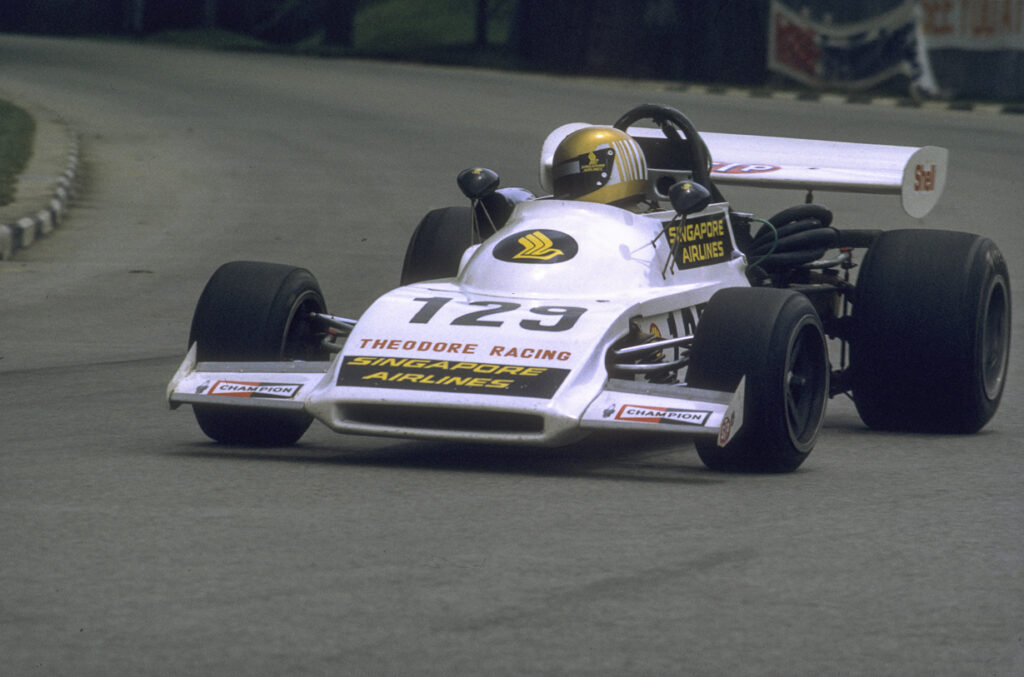
Teddy Yip backed Vern Schuppan in the early 1970s while Singapore Airlines provided the freight services in 1973. Schuppan repaid the support with victory in the 1973 Singapore Grand Prix in his March 722 (with revised Denis Falconer bodywork and front mounted radiator) 24
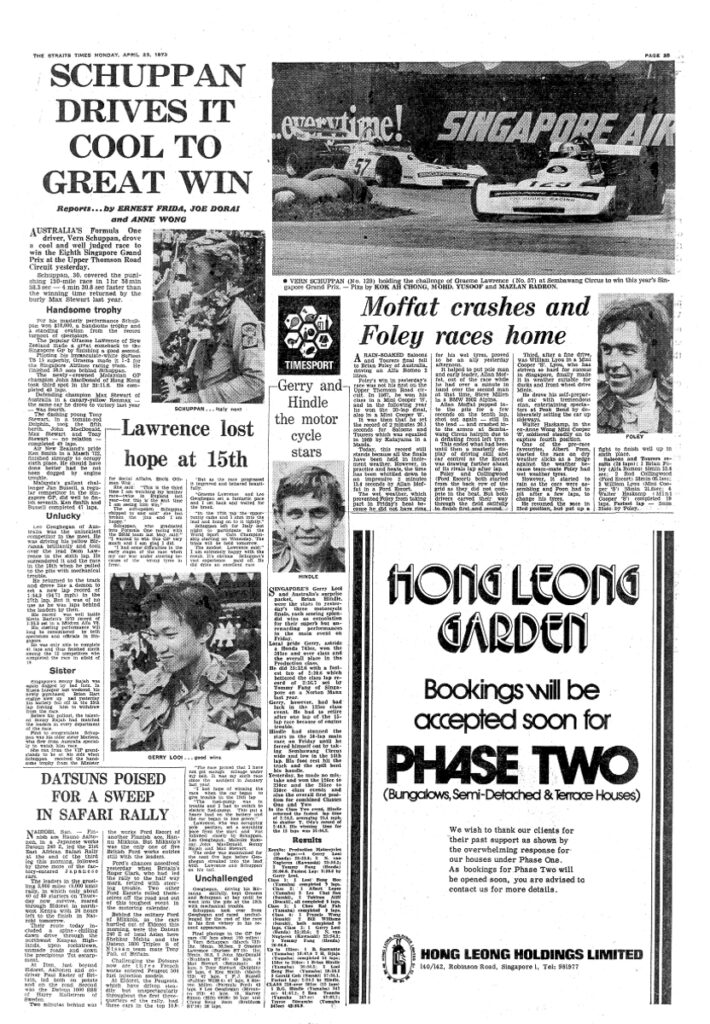
A March Grand Prix victory in Singapore. This was the last time a Grand Prix was held on the island until 2008!
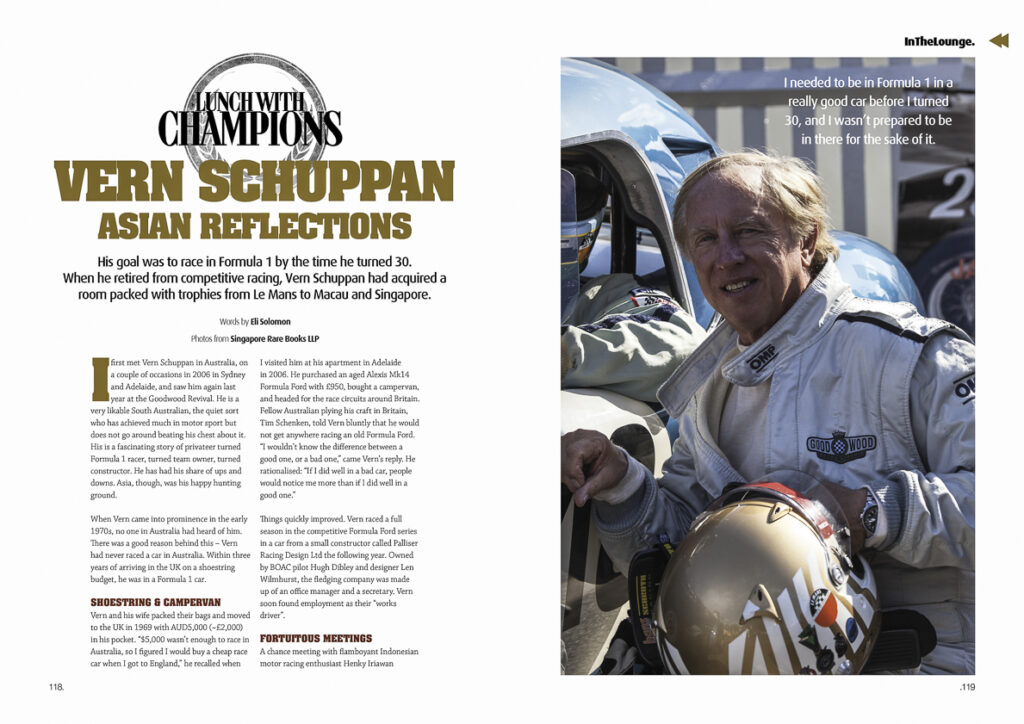
Rewind Magazine (Issue 013, January 2013) featured Vern Schuppan in its Lunch With Champions series. [See LUNCH WITH CHAMPIONS – Vern Schuppan]
SMOKE, MIRRORS, ROLL BARS & WINGS
Whether or not Sonny Rajah’s 73B or 732 was retained once it returned to the UK (if indeed it returned) has not been established by the writer. There were some stark differences between this 73B (that raced at Shah Alam and Singapore in 1973) and both Sonny’s 712M (post upgrade) and the 73B that arrived in Malaysia in August 1973 which the Singapore and Malaysian racing experts will undoubtedly be able to clarify.
The visual differences between both 73Bs are as follows: roll hoop (chrome on the August 1973 import, black in the 1973 Singapore Grand Prix car); rear wing side plates differ; and wing mirrors differ; front nose (splitter on the August 1973 import, none on the 1973 Singapore Grand Prix car). Many of these may have been changed while the car was back in the UK from May 1973 but it still begs the question – Was this the same car that returned to Asia in August 1973?
MARCH ON THE ROAD AGAIN
Sonny Rajah made his first appearance in the UK races at Round 3 of the Yellow Pages series at Silverstone on 20 May 1973. His blue #15 car is listed in the official program as a 712M25 with Ford BDA RES 1,600cc motor. The entry was under Scott Gormley (who, for a time, lived in Singapore and was involved in the formation of the New Nation daily tabloid in January 1971). Sonny finished in ninth place. It is interesting to note that Sonny lamented that the 712M’s upgrade work (a strengthened monocoque and new bodywork) was not completed until late July 1973, which means Round 3 was run in the 73B, as were most (if not all) his UK races that year.

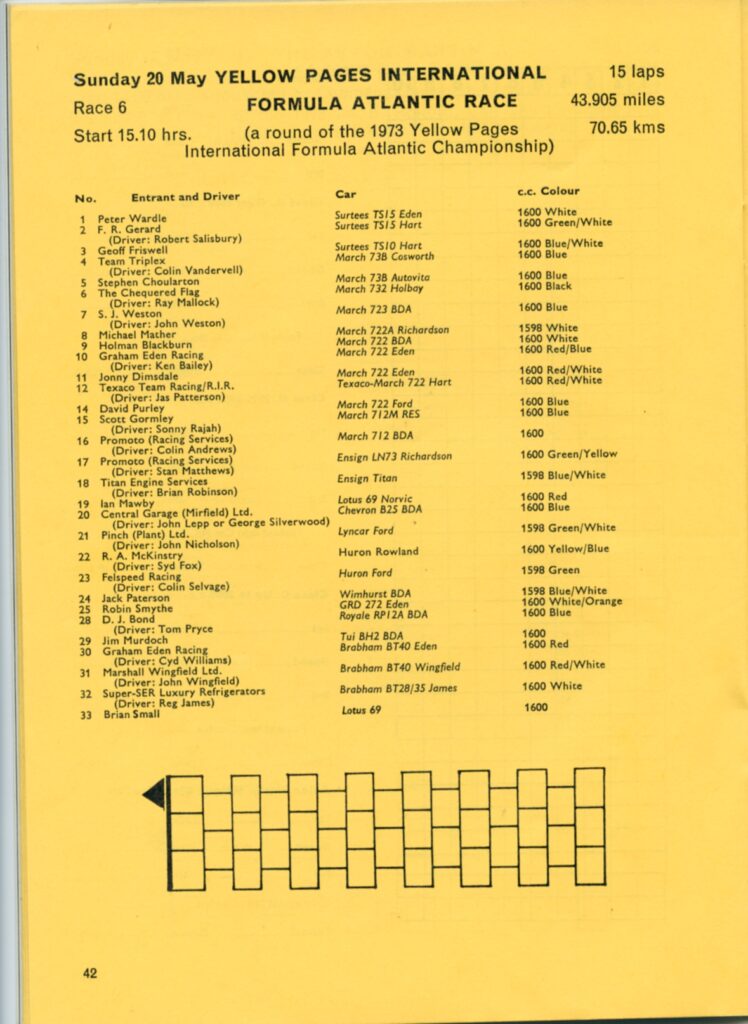
Round 3 of the Yellow Pages Formula Atlantic Championship was held at Silverstone on 20 May 1973 at the Martini International Super Sports Meeting. Sonny’s car was listed as his March 712M. The Singapore newspapers listed the car as his “new” March 732. 26
Sonny was at Brands Hatch for Round 4 on 27 May 1973, entered as car #4, officially with the March 712M but now minus Scott Gormley as Entrant. Sonny retired after 18 laps (of 25 laps), having qualified eighth. It is likely that the car Sonny raced was his 73B.
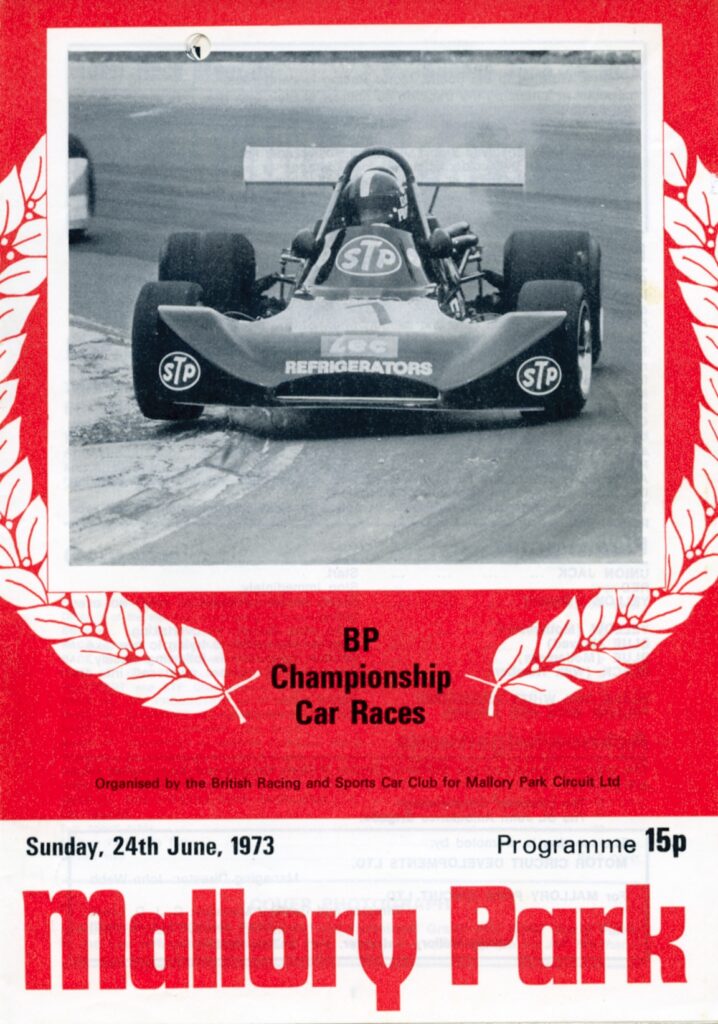
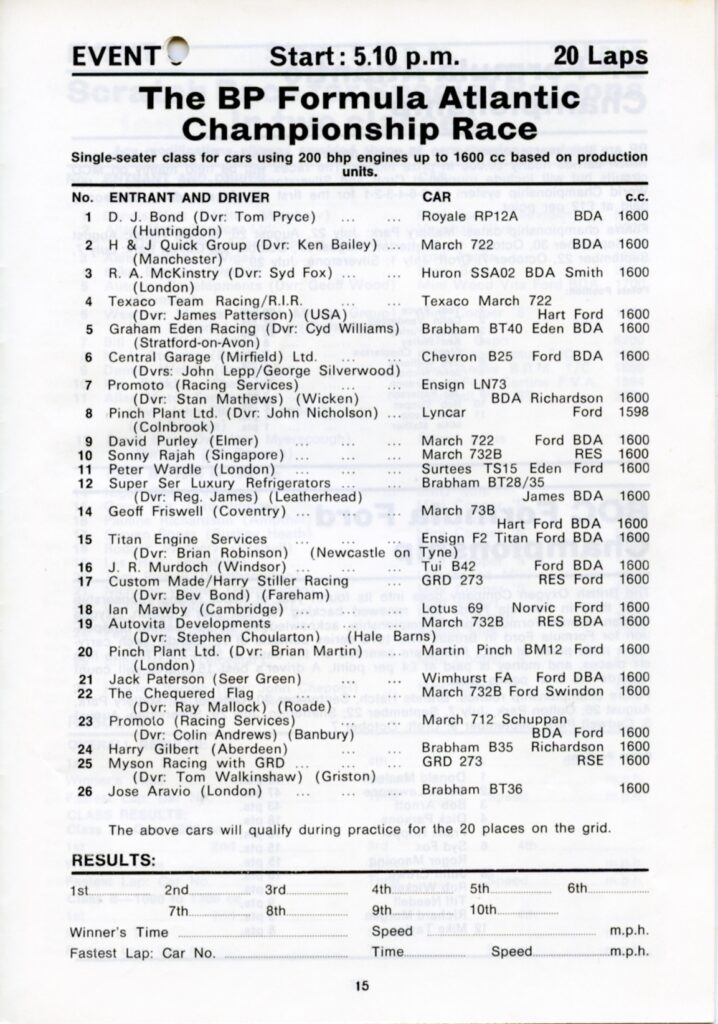
The first time the 1973 official programs list Sonny Rajah in the March “732B” was at the Mallory Park BP Championship Car Races on 24 June 1973.
Interestingly, Sonny was entered for Round 6 of the BP National Championship race at Mallory Park on 24 June, running #10. The official program lists Sonny’s entry as a March 732B RES 1600, the first instance the 732B is associated with him for the 1973 UK races in the official programs. In the race he retired on lap 2, having qualified in eighth place.
Sonny was at Croft on 1st July for Round 7 of the BP series, running #10. He retired on lap five due to an accident, having qualified eleventh for the race.
The records show Sonny did not race at Round 8 of the BP Series at Oulton Park on 7 July (#4 entry).
Sonny was at Silverstone on 14 July for Round 5 of the Yellow Pages Series with race number #16. His final placing is not known but he qualified 18th out of 29 cars. Interestingly his entry is listed with a Ford BDA Hart motor, not the usual BDA RES motor run previously.
Round 9 of the BP Series was held at Mallory Park on 22 July and Sonny and his #15 73B finished an impressive fourth in the 20 lap race, having qualified in fifth place. The car was listed with a Ford BDA RES this time.
Round 10 of the BP Series took place At Silverstone on 28 July. Sonny was entered with race number #8 though it is possible that he did not attend the race (he was not on the list of qualifiers).
The last time his name was on a 1973 UK race program was for Round 11 of the BP Series at Brand Hatch on 12 August, race number #39. He did not arrive – but that’s probably because he, the 73B, and the facelifted 712M, were on the way back to Malaysia.
All in all, Sonny entered the 73B entered in six races in the UK during the 1973 Yellow Pages and BP Series. The car was freighted off to Singapore in August 1973.
SWITCHING CAMEL
Enter Camel-sponsored Percy Chan. The Malaysian already had single-seater experience in a Brabham as well as the ex-Johnny Dimsdale Lotus 69. There must have been overtures from Rothmans because Percy soon found himself testing Sonny’s 73B at Brands Hatch in the autumn of 1973. Team Rothmans was soon to become a three-car outfit for the Selangor Grand Prix in September 1973.

John Dimsdale’s 1972 Macau Grand Prix Lotus 69 car was purchased by Malaysian Percy Chan after Dimsdale’s unsuccessful drive in Macau that year. Chan employed Dimsdale’s chief mechanic Michael Jackson (right) to restore it for the 1973 Malaysian Grand Prix. Resplendent in Camel-Malindo racing livery, the car was displayed at the Cycle & Carriage showroom in Kuala Lumpur alongside Harvey Simon’s 1972 Selangor Grand Prix-winning Elfin 600SA. The Camel team consisted of Simon (left), Chan (with necktie) and motorcycle racer Sonny Soh (second from left).
Having said that, perhaps Sonny now found himself with one March too many, his 712M upgrade 27 now allowing him the flexibility to cut a deal with Rothmans/Percy Chan to take the 73B off his books. The pair still needed to fund the freight of both the 732/712M and 73B back to PJ for the Selangor Grand Prix but that was sorted out once Michael Jackson, John Dimsdale’s former mechanic, got involved.
Percy Chan later revealed that a deal was worked out where he could appear in the March 73B for the Selangor Grand Prix but had to use his old RES 1,600cc engine from the ex-Dimsdale Lotus 69 as it was too expensive to buy a newer motor. The Lotus 69 was put up for sale, complete with spares.
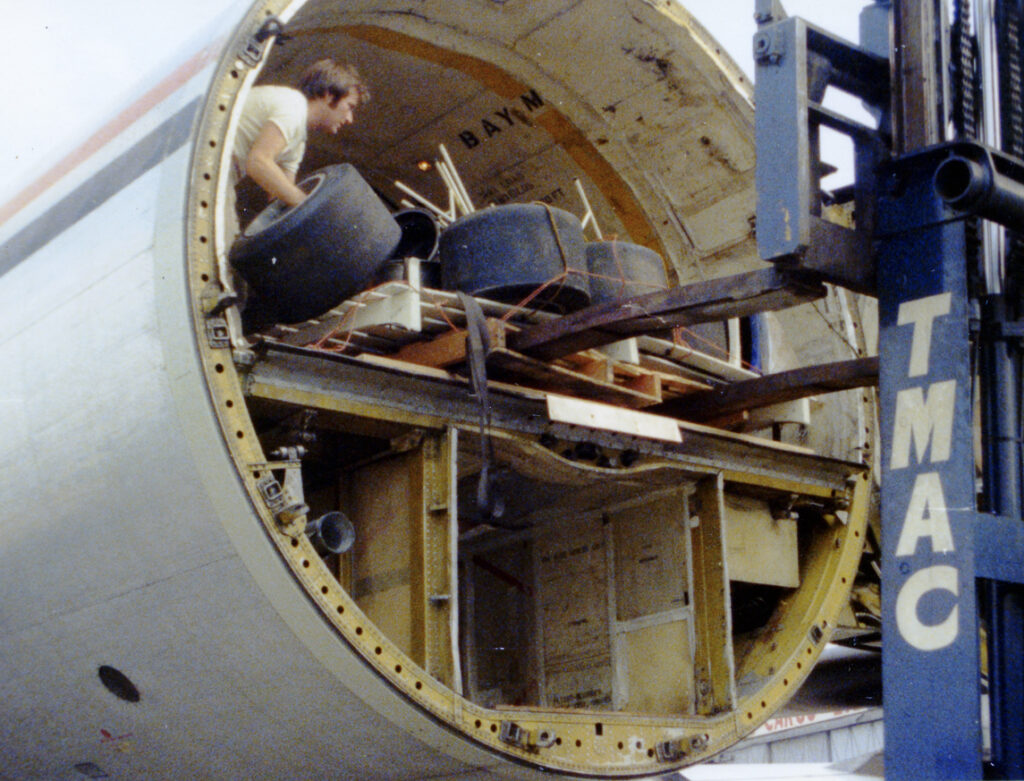
Michael Jackson packs the two March racing cars aboard the Transmeridian Pacific Trader.
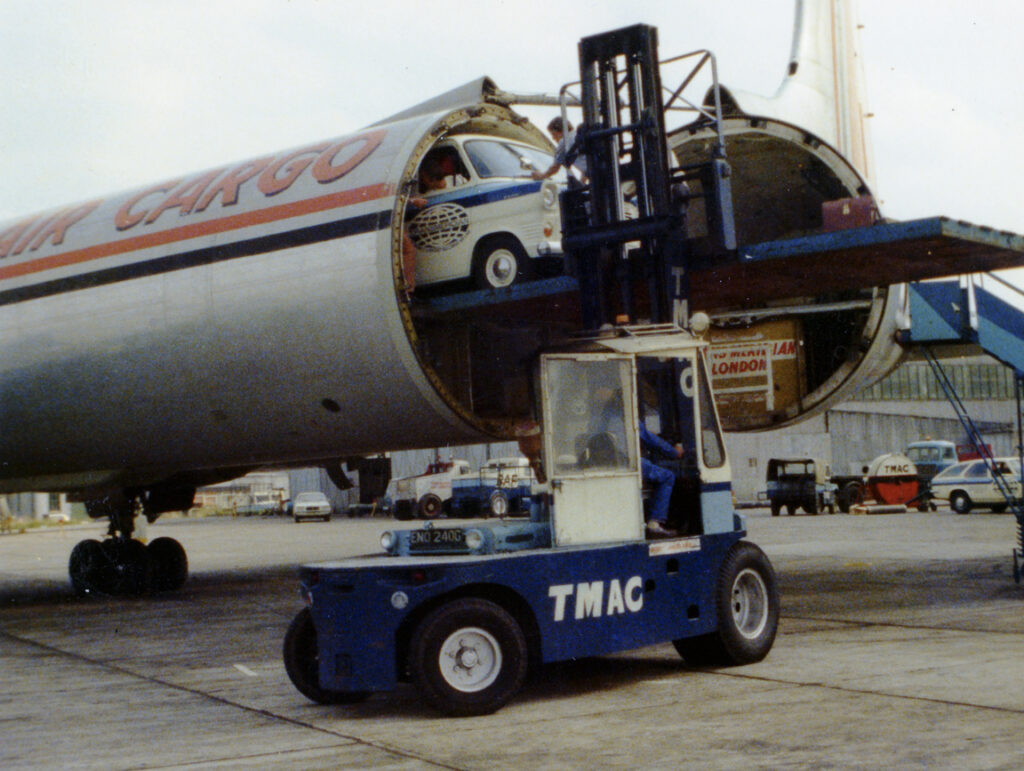
Jackson’s Ford Transit van is forklifted aboard the Transmeridian Pacific Trader bound for Paya Lebar Airport in Singapore.

Sonny Rajah and Michael Jackson board the Transmeridian Air Cargo CL44 turboprop for the flight down to Singapore.
Transmeridian Air Cargo flew both cars down – part of a sponsorship deal that involved Michael Jackson. Included were Mike’s Transit van. The plane? An old Canadair CL44 turboprop. This allowed them to ship the cars complete, and therefore ready for Selangor, rather than having to piece back the cars in Malaysia.
Transmeridian flew the cargo down to Singapore and the Ford Transit van was then driven up to Petaling Jaya, heavily laden with parts and tools. The cars were garaged at Cooperative Autoworks Malaysia’s (CAM) facilities in Petaling Jaya. CAM belonged to the Malaysian Cooperative Insurance Society (MCIS), of which Sonny Rajah’s father, Dato’ N.A. Kularajah28, who by then was known as the father of Malayan co-operatives, was a senior member.
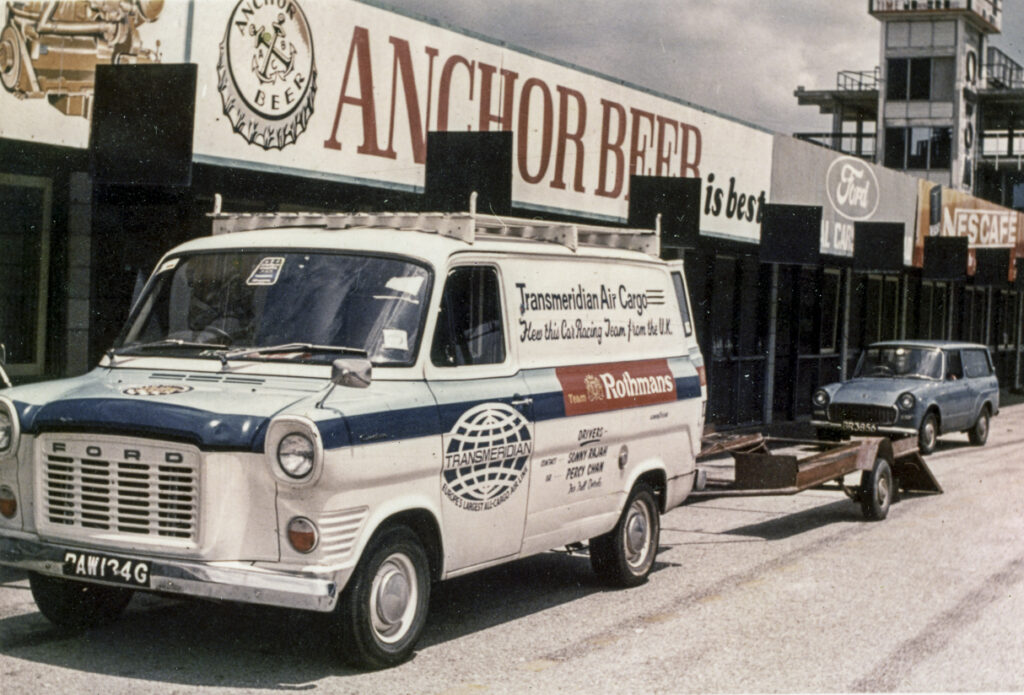
The panel read “Transmeridian Air Cargo Flew this Car Racing team from the UK.” Michael Jackson’s Ford Transit van in the Batu Tiga Circuit paddock in 1973.
The task of assembling the newly arrived March 73B fell to Sonny and Percy’s mechanic Michael Jackson, John Dimsdale’s mechanic during the 1972 Macau Grand Prix. Percy, the 1973 Malaysian Motor Sports Club’s Club Captain, was to race the 732 at the Selangor Grand Prix (9 September 1973) while Sonny would be in his uprated 712M. Then both cars were painted in the Team Rothmans’ blue livery. The MMSC’s Vice President was Rothmans’ Gerald Vessey29 [see SMOKE GETS IN YOUR EYES].
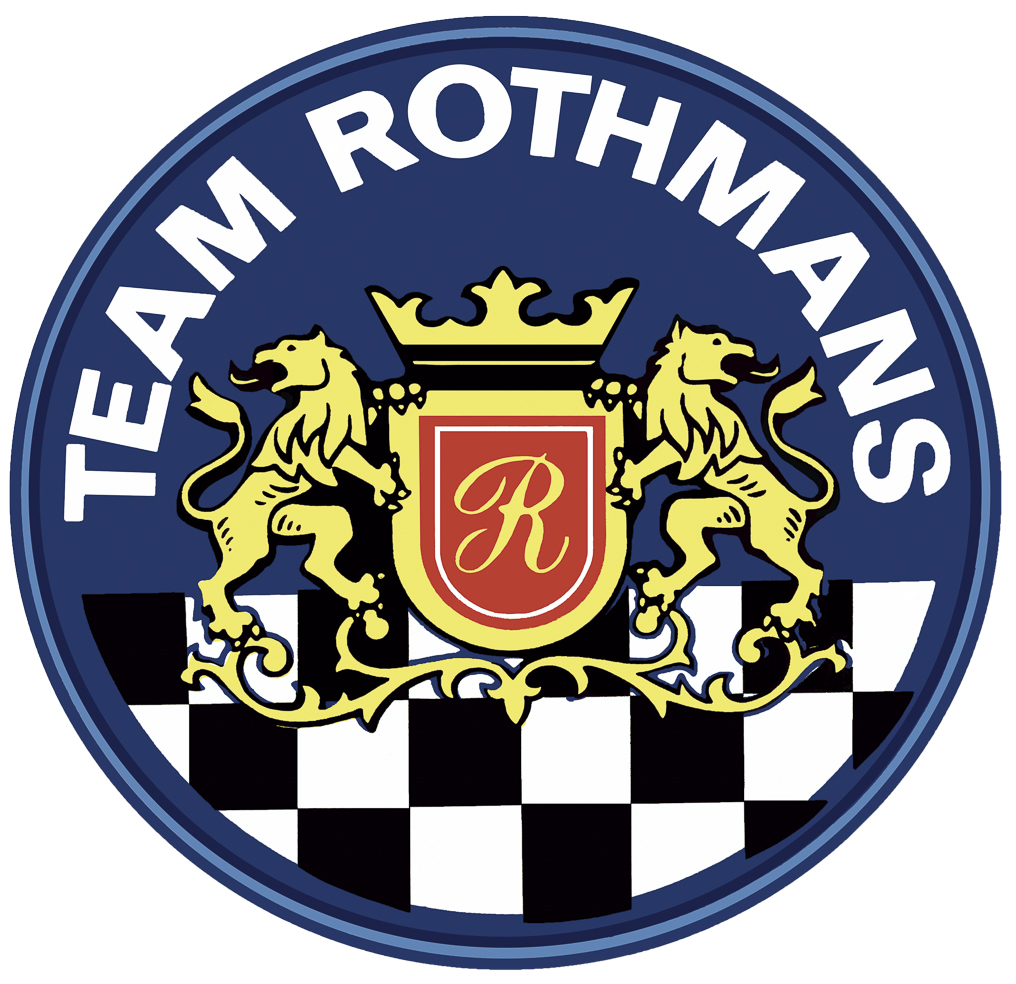
Team Rothmans’ press release for September 1973 read as follows:
TEAM ROTHMANS have just disclosed their mid-season plans for the Selangor Grand Prix to be held at the Shah Alam Circuit over the 8/9 September weekend.
In the 50-lap Main event for G.P. cars, the Team will be fielding three entries to spearhead Malaysia’s defence against the formidable overseas challenge. Percy Chan, well-known Malaysian driver will debut in the Rothmans-coloured March 732 powered by a 1600cc RES engine. His team-mates, Jan Bussell and Sonny Rajah will be in their Palliser and March 712 machines, both with Brian Hart engines.
Sonny, who only recently returned from the Atlantic Series in the UK is quietly confident of a good race and the Rothmans March 712, which has been completely rebuilt and updated, is expected to perform well.
The three drivers and their cars in their new colour design will be on exhibition for one day on Saturday, 1st September, 1973 at the ground floor foyer of the Ampang Park Shopping Complex. All racing fans interested in meeting Jan, Sonny and Percy and talking racing will be most welcomed.
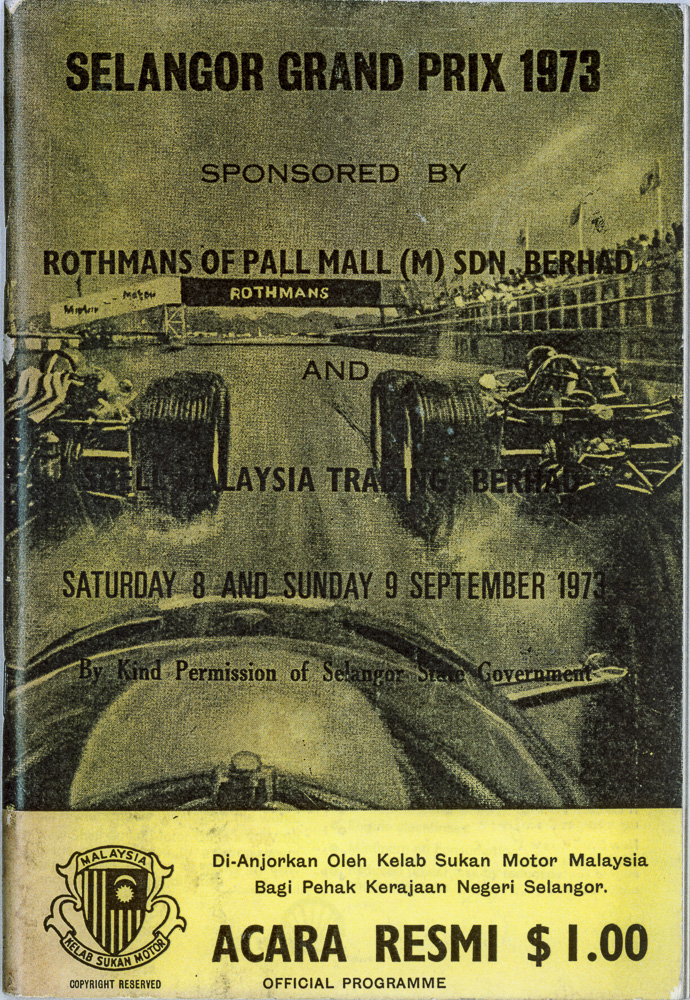
The serious competition consisted of three Brabhams, two March, a Surtees, a Palliser WDB3 and an Elfin 600.
For the Grand Prix, Sonny’s March 732/712 race entry was #1. He started on the front row, pole set by Graeme Lawrence in his #6 Singapore International Airlines Surtees TS15. Alongside Sonny, in third, was Hong Kong’s John Macdonald in his #11 Cathay Pacific Airways Brabham BT40 Hart Twin Cam. The second row was made up of Team Rothmans’ Percy Chan in the #15 March 73B and Jan Bussell in his #14 Team Rothmans Palliser WDB430.
While the grid wasn’t as impressive as the Malaysian Grand Prix grid, Sonny still took the March by its horns and proved he had the credentials to make it internationally, if he had the right support. The young Malaysian took his second Grand Prix win in Malaysia and in the process, set FTD at 1:20.4. At the end of the gruelling 50 lap race, the standings were as follows:
1 – Sonny Rajah March 732/712M 1 hr 9:46.7 (FTD 1:20.4)
2 – Graeme Lawrence – Surtees TS15
3 – Percy Chan – March 73B (1 lap behind)
4 – Jan Bussell – Palliser WDB3 (2 laps behind)
5 – John Macdonald – Brabham BT40
6 – Eddy Choong – Chevron B8
EXIT PERCY, ENTER BUSSELL
Things were really looking up for Team Rothmans and a two-car team was earmarked for the upcoming Macau Grand Prix. Team Rothmans consisted of Sonny Rajah and double Macau winner Francis Jan Bussell. By 3 November 1973 Bussell had acquired the 73B that Percy Chan raced earlier in September. Sonny of course retained his 732/712M. Bussell had also met up with Sonny in the UK during the summer of 1973 but was unable to purchase a suitable racing car for export to Malaysia.
The 73B was a simpler deal for Bussell – the car was already in Malaysia and had been tested by Percy Chan (with a fine third place finish in the Selangor Grand Prix). Bussell did have a new motor for the 73B, a Brian Hart Fuel Injected unit that he had purchased in the UK earlier in the year.
Bussell’s car details for Macau came rather late, hence the lack of a race car associated with his entry in the 16-18 November 1973 Macau Grand Prix program31 [see illustration below].
MARCH TO MACAU
The Malaysian Team Rothmans cars were freighted to Macau on Saturday 10 November for the 16-17-18 November Grand Prix. 24-year-old Michael Jackson accompanied Sonny and Jan as crew chief. He later jumped ship in Macau following the Grand Prix, joining John Macdonald’s racing team that was managed by Alan Dingle, barely three months after moving to Malaysia.
There were a total of five March racing cars at Macau in 197332 and two made it to the front row for the start. Winning was another matter altogether.
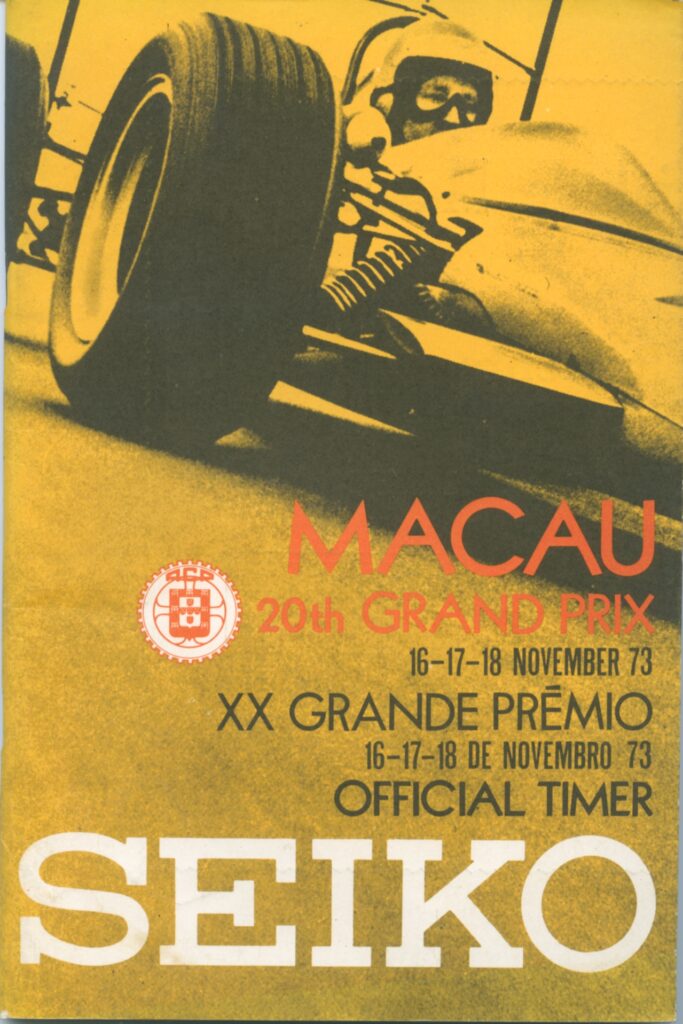
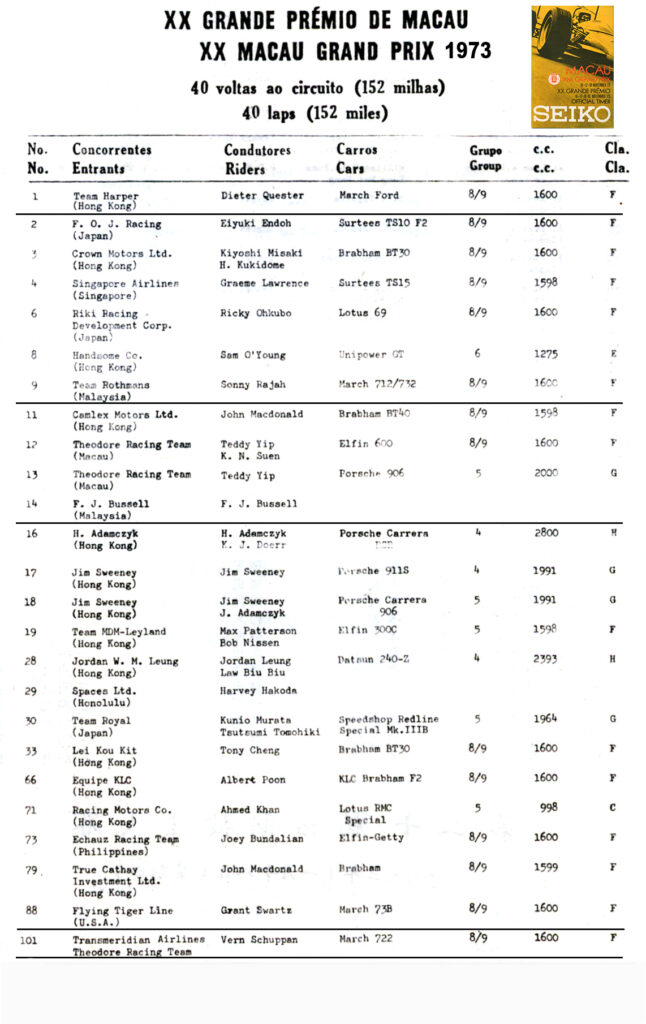
The 1973 Macau Grand Prix was held from 16-18 November 1973 and featured five March entries – The Team Harper #1 March 722 for Dieter Quester33; Team Rothmans #9 March 732/712M for Sonny Rajah; Team Rothmans #14 March 73B for Jan Bussell; Flying Tigers #88 March 73B for Grant Swartz; and Theodore Racing (inaugural race for the team) #101 March 722 for Vern Schuppan. The March entries are underlined.
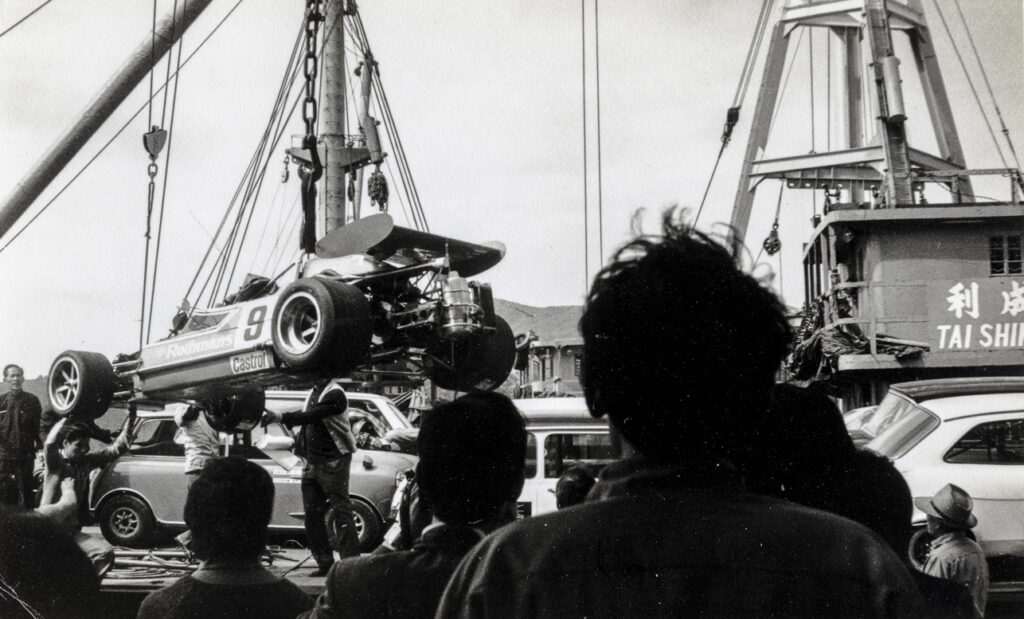
Minis form a cushion on the platform as Sonny Rajah’s 732/712M is loaded aboard for the ride to Macau.
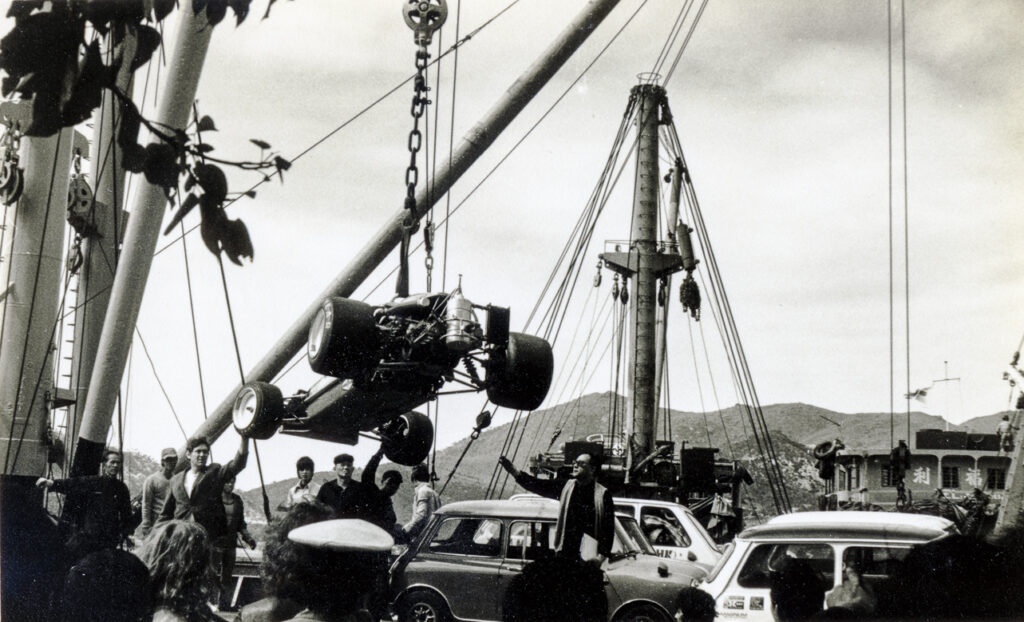
Jan Bussell made sure his car was handled with care for its journey to Macau from Hong Kong.

The 1973 Macau Grand Prix gird showing John Macdonald on pole in his #11 Brabham BT40, Vern Schuppan in the middle with his #101 March 722, and Sonny Rajah in his #9 Team Rothmans March 732/712M. Sonny, down on horsepower compared to eventual winner Macdonald, finished an even more impressive second, barely half a minute behind Macdonald.
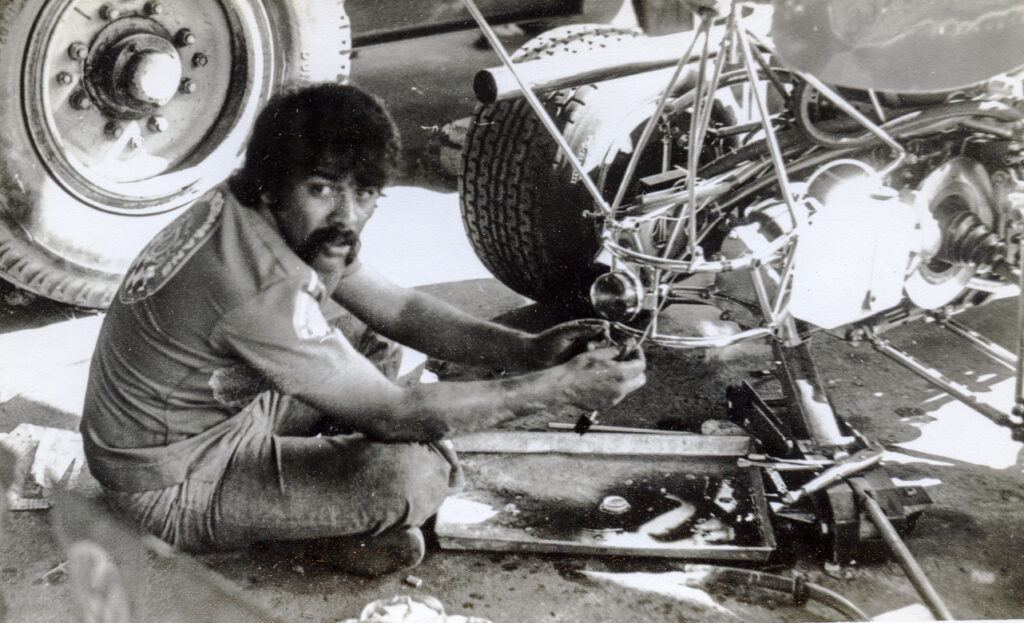
Not an idle moment for Sonny Rajah before the 1973 Macau Grand Prix. John Macdonald, one of Asia’s top drivers, said that Rajah “had brilliant car control…a natural talent with character to boot.” Having trailed Sonny around Macau one year, he also observed that Sonny had “made contact with much of Macau’s scenery [that] in itself is a very difficult act.” A bit harsh but Macd was never known to mince his words.
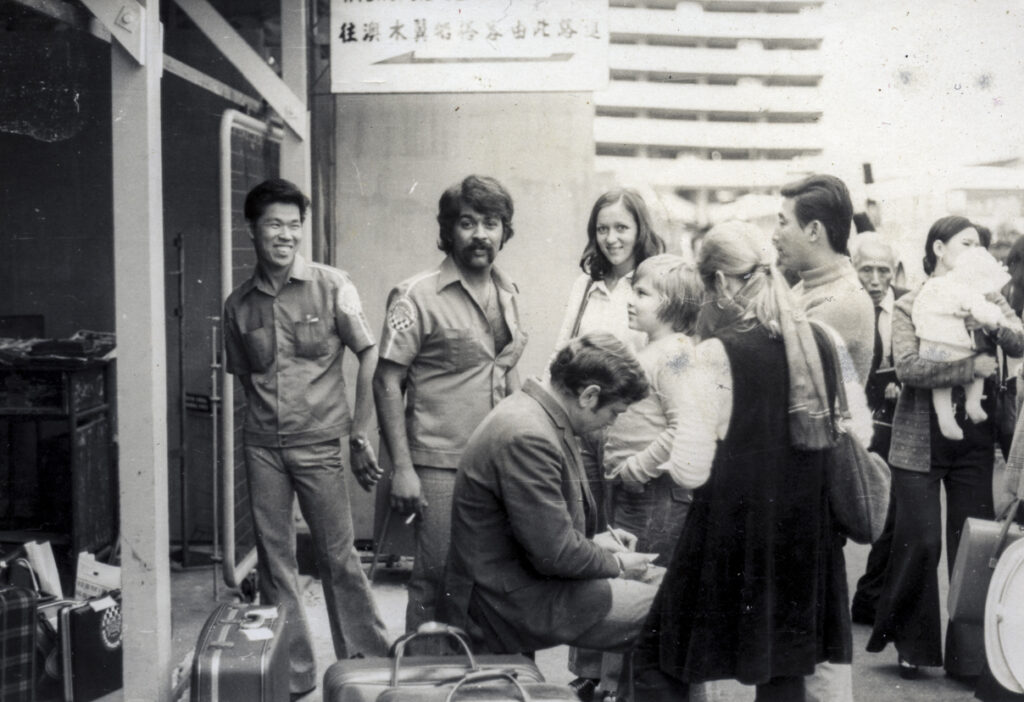
Jan Bussell (seated) enjoying some attention with Sonny Rajah in Macau. Bussell’s Torque Shop mechanic Choy Hock Wah (left) enjoys the moment. Choy had spent six months at Vegantune in the UK in 1971.
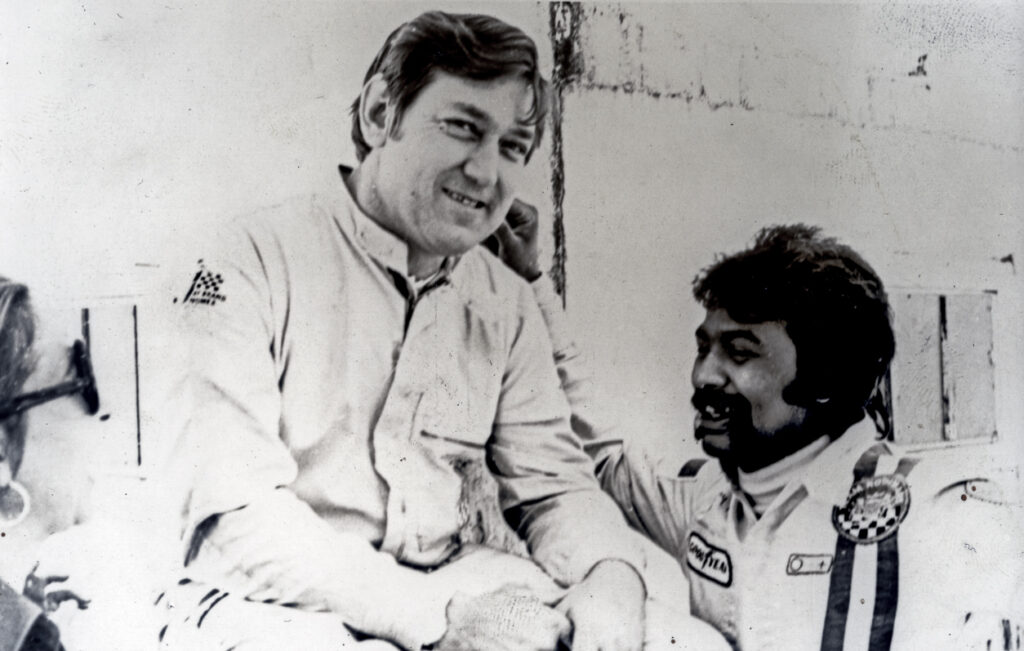
Team Rothmans pair from Malaysia enjoying a moment before the 1973 Macau Grand Prix.
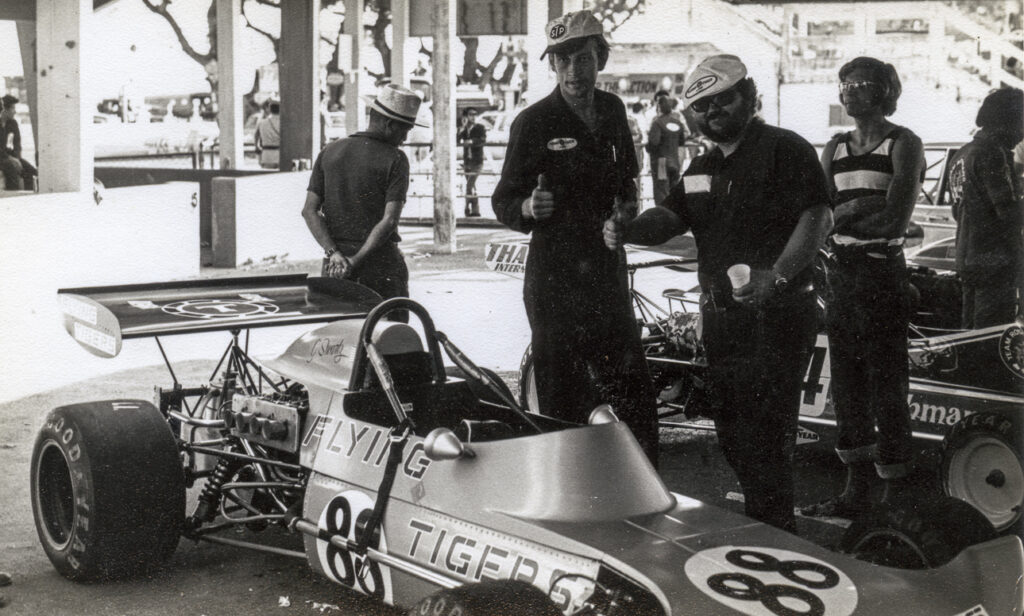
American Grant Swartz’s Flying Tigers crew alongside his #88 March 73B in the Macau paddock. Over the years the car received some serious modifications (including side mounted radiators), transforming it into a 75B. Nick Van Nugteren later owned the car and raced it in Malaysia (1976/1977).
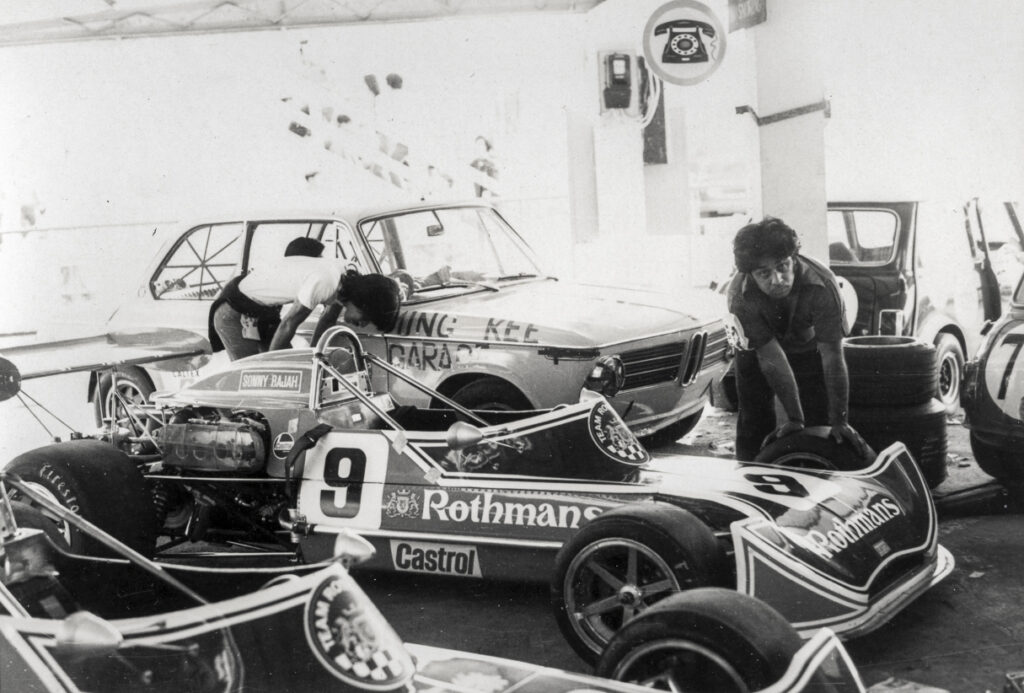
Teddy Yip was around to lend racing drivers a hand – including the use of his main race mechanic Ashok ‘Ash’ Vadgama, pictured by the front wheel of Sonny Rajah’s March 732/712M in Macau.
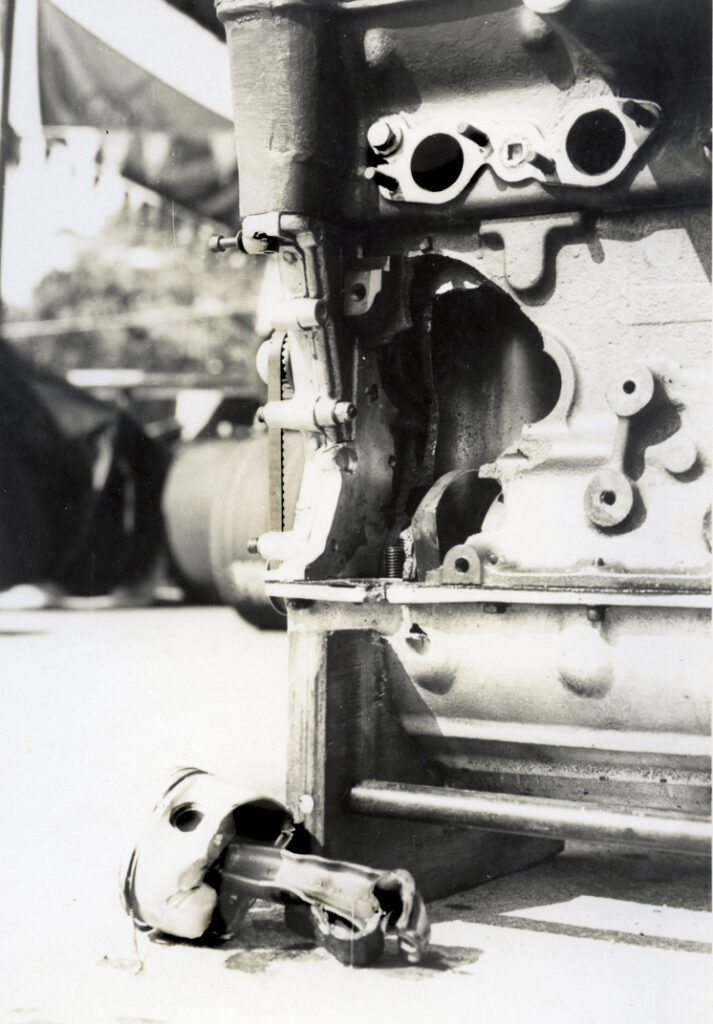
Jan Bussell’s lucky streak in Macau (he had already won two Macau GPs) came to an abrupt end at the 1973 Grand Prix when a con-rod let go and vented his new Brian Hart block.
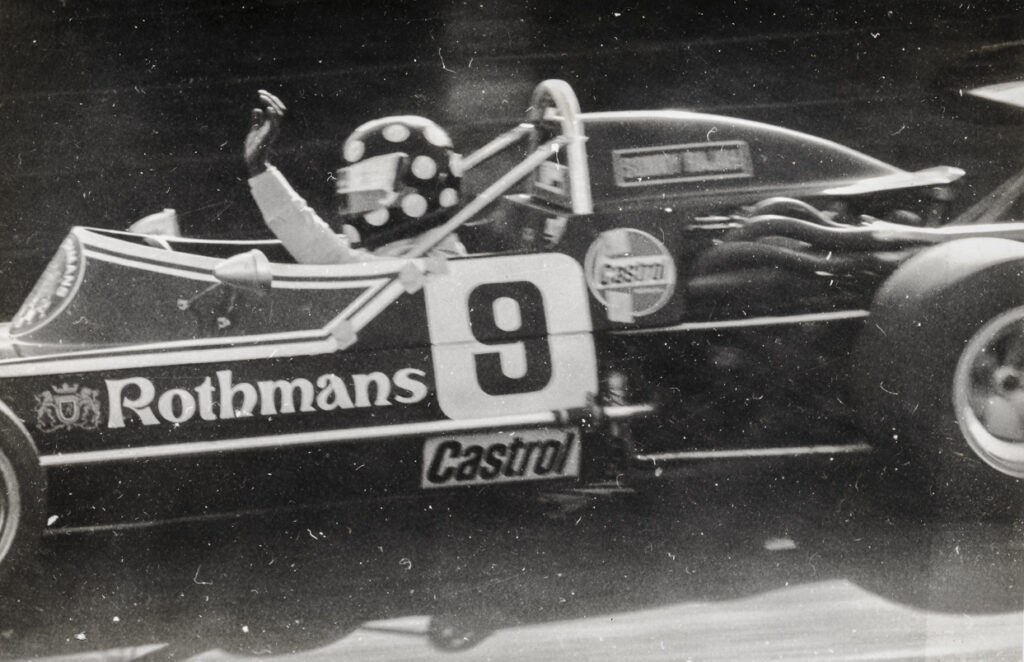
Sonny Rajah, best (and only) March finisher at Macau in 1973 with second place. Quester and Bussell had a blown engines, Schuppan crashed between Moorish Hill and Donna Maria Bend and Swartz wrecked his 73B at San Francisco Barracks (and broke his ankle in the process). Macau had a habit of giving owners a good reason to “update” their cars.
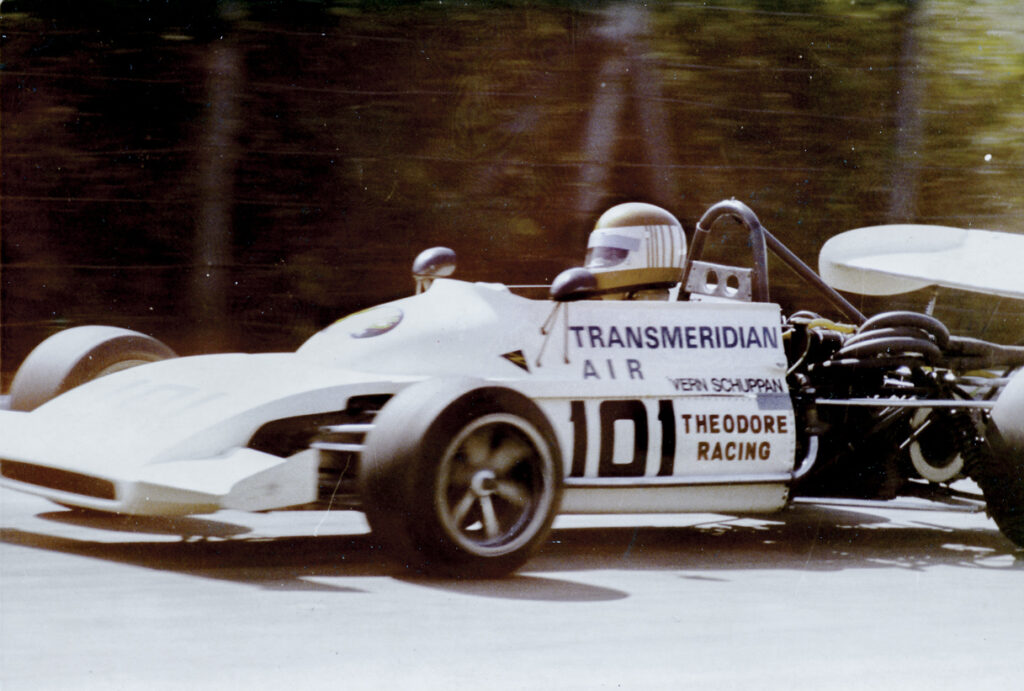
Vern Schuppan’s Theodore Racing March 722 in action in Macau, 1973.
SMOKE SCREEN
Rothmans were one of the biggest backers of the sport in Malaysia but there was more that was needed to boost interest in the local Grand Prix and key supporting races which the 1974 Secretary of the Meet, Rothmans’ Chin Kui Yin was scratching his head over. Chin was also Rothmans’ racing team manager, instrumental in supporting the acquisition of the March 732 cars that permitted drivers like Sonny Rajah, Percy Chan, Jan Bussell, Harvey Yap and Pocholo Ramirez to race in the early and mid-1970s.
Sitting on the General Committee of the MMSC as well as being Secretary of Race
Organising Committee of for the Shah Alam races meant Chin was in the thick of things from 1974 until just after the formation of the Shah Alam Motor Racing Association (SAMRA) in 1978.
The aim of the race committee was to attract top drivers from the region and around the world, ensure that there was starting money, raise the prize money for the racers and keep things exciting. The MMSC were the controlling body of the sport in Malaysia in the early 1970s, until the formation of SAMRA.
Rothmans backing was significant, not just as title sponsor but for the drivers and the cars Rothmans funded. In fact, Harvey Yap sprung a surprise when Rothmans backed his entry in the single-seater for the Malaysian Grand Prix in March 1975 with the 722-tubbed March the company purchased for Percy Chan to race in April the previous year.
This was Harvey’s debut in top flight Atlantics and he wasn’t far off the pace, qualifying third, behind the more powerful cars of John Macdonald (Brabham BT40) and Albert Poon (Chevron B29). Percy, meanwhile, had financial support from Rothmans and was able to loan Sonny Rajah’s March 732/712M for the weekend while Sonny entered a spell of semi-retirement following a year of racing in the Australia Van Heusen Formula 2 Championship in 197434. But all that’s for Part 2 of RICES OF MARCH.
So ends Part 1 of RIDES OF MARCH. The cars featured in Asia in this article include the Vern Schuppan/Theodore Racing 722-40; Ken Smith’s 722-1; Grant Swartz’s 73B-13; Team Harper’s 722-10; Sonny Rajah’s 712M-7; and Sonny Rajah’s 732B.
Part 2 (1974-1977) will include the arrival of the third Rothmans March (a 722/732), Sonny Rajah’s entry in the Australian Van Heusen F2 championship and the various other March entries in the region, including the Macau and Philippine races.
RIDES OF MARCH
END OF PART 1 – 1971-1973
Words by Eli Solomon. You can reach the writer at [email protected]
Appendix 1 – TUBS OF MARCH
Tracking chassis/tub numbers for any racing car is a tedious task fraught with danger. My late friend and contributor to Rewind Magazine, Dr. Mike Lawrence, wrote about this in his book The Story of March – Four Guys and a Telephone. In his Introduction to Appendices he wrote: “March’s own records say four F1 cars were made in 1973, but since these were merely modified 721Gs I maintain no F1 cars were built in 1973, so while they were entered as 731s no such animal existed in the metal, only in the paperwork. The picture becomes more complicated as, say, 741s were stripped down and rebuilt as 751s, and 751s became 761s, and as a 771 became a 891…” That’s just the Formula 1 cars.
It is an accepted fact that the 712 (and its derivatives), the 722 (and its derivatives), the 732 and the 742 and its derivatives are basically all quite similar. Works and some favoured customer cars got better quality aluminium in the construction of their tubs. One March type could easily morph so easily to another – a 712 into to a 732 to a 752-look (though from the 752 through to the 772, the tubs were structurally different).
Now let’s see what Mike Lawrence said about the junior formulae. “Damaged frames went back to Arch Motors and serviceable frames were returned, end of story…There was, too, an exchange deal operating in the early days of the monocoque cars: you took your damaged tub to Bicester, paid the estimated cost of repair and came away with another tub while yours was repaired and entered the exchange pool. It was an imaginative scheme from the customer’s point of view, but it does demonstrate some of the pitfalls of placing too much emphasis on chassis plates.”
All this makes tracing the pre-Asian history of the South East Asian car a very interesting exercise.
BIBLIOGRAPHY
Newsome, Philip. Colour and Noise: 40 Years of the Macau Grand Prix. A.S. Watson (1993).
Newsome, Philip. Teddy Yip – From Macau to the World and Back. Blue Flag Press (2012).
Mosley, Max. Formula One and Beyond: The Autobiography. Simon & Schuster (2016).
Lawrence, Mike. The Story of March. Motorbooks International (1990).
Hodges, David. A-Z of Formula Racing Cars. Bay View Books (1998).
Solomon, Eli. Snakes & Devils: A History of the Singapore Grand Prix. Marshall Cavendish (2008).
Footnotes
- March Engineering began operations in 1969. Its four founders were Max Mosley, Alan Rees, Graham Coaker and Robin Herd. The company name is an acronym of their initials – “M”osley, “a”, “R”ees, “C”oaker, and “H”erd. According to Mosley in his Autobiography (Formula One And Beyond, Simon & Schuster (2015): “The ‘a’ was because with the initials of our four surnames we needed a vowel to make it into a word.” They each had a specific area of expertise: Mosley looked after the commercial side, Herd was the designer, Rees managed the racing team and Coaker oversaw production at the factory in Bicester, Oxfordshire. Source: https://en.wikipedia.org/wiki/March_Engineering. The March business model was predicated on the company funding its Formula One cars/team in 1970 by building Formula Two, Formula Three, Formula Ford and Can-Am cars for customers.
- Race by race accounts for Ronnie Peterson’s 712M-7 for the 1971 Formula 2 season can be found in Allen Brown’s OldRacingCars.com https://www.oldracingcars.com/f2/1971/
- March Engineering followed a simple method of type-numbering – the first two numerals refer to the car’s year and the third to its formula. So the 712 was a 1971 model, for Formula 2 racing.
- In the fourth quarter of 1971 March Engineering Ltd. advertised the Works 712M entries of Jaussaud, Jarier and Lauda for £ 2,450 each (less engine). Frank Williams (Racing Cars) Ltd. offered chassis #2 (Derek Bell), Chassis #4 (Henri Pescarolo) and chassis #20 (Carlos Pace) for sale at £2,250 with FT200 box but not engine. So Sonny Rajah would have had a fairly good variety of cars available through both March Engineering’s Bill Stone as well as Frank Williams, not to mention the large number of Brabhams available. However, chassis #7, the Ronnie Peterson Championship-winning car, was not advertised in either Autosport or MotorSport.
- Bill Stone was March Engineering Ltd’s first official employee when the company was first established. He began as Production Manager before moving taking on the role of Sales Manager. In the middle of 1973, Stone left March to start up Sabre Automotive in Bicester, a fabrication company doing specialized work for Formula 1 and Formula Ford. The directors were Stone and Adrian Reynard.
- Straits Times, 10 October 1971, pg. 29. March aims to win motor racing mart, by A. Johnson.
- An estimated 20 712M monocoques were built for Formula 2 and the cars ran Cosworth (or in one rare example, a BMW) motor. The 1972 F2 car was the March 722, now with 2-litre Cosworth BDF or more commonly used Cosworth BDA motor. The 722 was also adapted for Formula Atlantic and Formula 3 (with Lotus Ford Twin Cam motors and a Hewland Mk8 transmission (instead of the strong FT200 box).
- Sadly Lionel Chan perished in the April 1972 Singapore Grand Prix while racing his Brabham.
- De Cotta, Ian. The Singapore Grand Prix: 50 Years in the Making. Mediacorp Singapore (2008).
- Sonny Rajah first appeared in the Lotus 69 (uprated from 59 spec.) at the April 1971 Singapore Grand Prix (the car only arrived a week for fore the Singapore Grand Prix over Easter. It was apparently purchased for S$27,000. [see Singapore Herald, 26 March 1971, pg 18]. It wasn’t a successful debut nor was the following weekend in Selangor for the Selangor Grand Prix any better. The car was then raced at the Penang Grand Prix 24-25 April 1971 (he won the six-lap preliminary race, beating Ken Smith in a Lotus 69 and Hengky Iriawan in an Elfin 600CS). In August 1971 Sonny set FTD at the Old Upper Thomson Road Sprint (as well as a new course record of 45.04 seconds). He was up at Batu Tiga for the Malaysian Grand Prix in September 1971, now with a crew consisting of KL-based Martin Howard and Australian Bob Staudinger. He started on the front row and finished second to John Macdonald, the only driver on the same lap as the winner! The last occasion the Lotus saw action was at the Macau Grand Prix on 20 November 1971 where, while convincingly leading the Grand Prix (even after a rear tyre blowout earlier), the car’s front suspension broke (with just eight laps to go!) and the Sonny’s race was over, the car wrecked as a result. It was later rebuilt in the UK but that’s another story.
- The demerger of Malaysia-Singapore Airlines into Malaysian Airlines System (MAS) and Singapore International Airlines (SIA) began with the incorporation of Mercury Singapore Airlines (oddly, also MSA) at the end of January 1972, an entity owned by the Government of Singapore. On 30 June 1972, the Singapore Government announced the official name of the new national carrier (Singapore Airlines, initials SAL). The name Mercury Singapore Airlines was dropped. Officially, the separation of Malaysian-Singapore Airlines took place from 1 October 1972 so the uncertainty as to whether Sonny Rajah’s freight came from Malaysia-Singapore Airlines or Mercury-Singapore Airlines in early 1972 is a moot point.
- Letter from Sonny Rajah to Brabham’s (Motor Racing Development Ltd.) Sales Manager Alain C. Le B. Fenn dtd 7 December 1970.
- See CLUBBING IN SOUTH EAST ASIA
- John M. Brown left Rothmans of Pall Mall Malaysia to take up the position of Managing Director of tobacco giant Carreras Ltd in London in January 1969. In November 1958 Carreras merged with Rothmans of Pall Mall. A manufacturing agreement was entered into and by 1961 the business had expanded to the point where Carreras had acquired the Rothmans cigarette and tobacco business in Britain and some of its overseas markets. As a result of this deal, the biggest shareholder in the operation became Rothmans Tobacco (Holdings). Carreras Rothmans Ltd was formed in 1972 when Carreras Limited was used as the vehicle for the merger of various European tobacco interests to form Rothmans.
- Rothmans of Pall Mall Malaysia escalated its interests in motor racing a step forward towards the end of the 1971 racing season. For the first time, the tobacco giant directly backed a Malaysian-based driver. Rothmans’ signature blue colour went on Jan Bussell’s McLaren M4C and Team Rothmans Malaysia was up and running for the 1971 Macau Grand Prix. Bussell, owner of an air charter business and a workshop in Kuala Lumpur (Torque Shop), delivered the goods after fellow Rothmans-backed entrant Sonny Rajah’s privately-entered Lotus 69 disintegrated on impact towards the end of the race. See Rewind Magazine 035, July 2017: Viewfinder – Tales From The Far East: Bitza Recycling.
- See CLUBBING IN SOUTH EAST ASIA
- Singapore Motor Sports Club Gazette, March 1972.
- Tate of Leeds were one of the biggest Ford dealers in the North East of England and had gotten involved in motor sports with a brace of single-seaters and V8-engined Fords. Tate Rallye Sport’s chief was Barry Smith.
- New to Wilson Fittipaldi in May 1971, replacing the Lotus 69 with which he had started the European F2 season. Raced by Fittipaldi for the rest of the season as part of Team Bardahl. Retained for one F2 race in early 1972, then sold to Tate of Leeds (Racing) and converted to Formula Atlantic for Chris Meek to race in the British championship. Loaned to Sonny Rajah for the Brands Hatch Boxing Day race. Retained by Tate of Leeds for Malcolm Wayne in early 1973, then sold to visiting American Allen Karlberg (Seattle, WA) who took it back to the US. See: Allen Brown’s https://www.oldracingcars.com/atlantic/results/uk/1972/brands-hatch/dec/#note4
- Lawrence, Mike. The Story Of March, Aston Publishing (1989).
- According to Mike Lawrence in The Story Of March, Aston Publishing (1989), March Engineering produced 14 Formula 2 732 cars and 22 Formula Atlantic 73B cars. For the Yellow Pages and BP Championship in the UK, the car would have had to comply with the Formula Atlantic rules. Out in Asia, the Singapore, Selangor and Penang rules stipulated 1.6-litre motors with two-valve per cylinder heads, which meant Ford Twin Cam units.
- The 1973 Yellow Pages series races were at Brands Hatch, Mallory Park, Oulton Park, Silverstone and Snetterton. The BP Formula Atlantic Championship had considerably more races. Both series were for single-seaters for cars using 200bhp engines up to 1,600cc capacity (based on production units).
- Schuppan’s March 722 was chassis 40 and was new to the Australian for the 1972 British Formula Atlantic season. The car first ran with a BRM Ford twin cam, later on with a BDA and for 1973, with a Richardson BDG. The car had a twin cam for the Singapore Grand Prix in 1973 and the same for the 1973 Macau Grand Prix.
- The 722 had been rebuilt in England by Denis Falconer, the Canadian aerodynamicist who worked with Vern and developed a more aerodynamic package for the car for the 1973 season. Falconer developed multiple body packages, depending on what sort of track the car would run on. The car also had a narrow-track suspension set up as well as a wide-track set up for circuits such as Macau. Vern would have a busy schedule in 1973, including having entered the same car in a European Championships Formula 2 race at Mallory Park in early March.
- Allen Brown’s OldRacingCars.com website lists Sonny’s car as a 73B. See https://www.oldracingcars.com/atlantic/results/uk/1973/silverstone/may/
- Straits Times 23 May 1973, pg. 27. Also see https://www.oldracingcars.com/atlantic/results/uk/1973/silverstone/may/
- Sonny’s Hart engine was rebuilt and the 712’s monocoque strengthened – possibly with a new tub that now incorporated the 73B’s forward facing roll bars. New bodywork replaced the wedge nose from the original 712M though the front radiator was retained.
- N.A. Kularajah was born 23 June 1921 in Ceylon. D. 17 May 1996.
- Gerald Vessey, Rothmans’ Malaysian Marketing Director, sat on the committee of the Malaysian Motor Sports Club as its Vice-President (from 1971 till circa 1974) he succeeded John E.D. Clinton as CEO of Rothmans Malaysia in May 1974. Vessey’s position as Vice-President of the MMSC was taken over another Rothmans man, Chin Kui Yin (K.Y. Chin) who held the position of Team Manager for the Rothmans racing team in Malaysia.
- The Palliser was in fact a WDB3 rather than WBD4 chassis 1
- The Macau Grand Prix was held 16-18 November 1973. The program listed Sonny Rajah as #9 Team Rothmans March 712/732 1598cc while Jan Bussell’s #14 (without reference to Team Rothmans) car was left blank.
- There were four Brabhams and three Elfins on the grid that year. The only other occasion that saw more March entries was in 1979 when there were no less than seven entries.
- Dieter Quester’s Team Harpers car was a March 722-10. Seems it was later sold by Team Harper. Unknown 722/732 cars in Asia include the Joey Bundalian March, first recorded at Greenhills Grand Prix, 7 July 1974 (Round 2); the Dean Moore March (with March 731 nose).
- Sonny had sponsorship from Melbourne shoemaker Julius Marlow for the eight round Van Heusen Formula 2 Series in Australia that was held between June 1974 and December 1974.

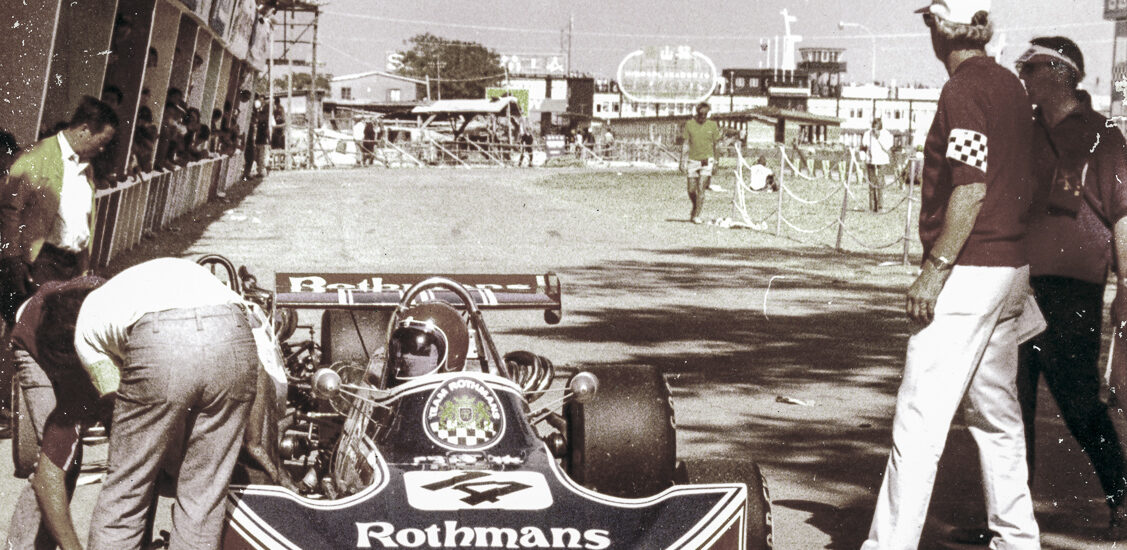
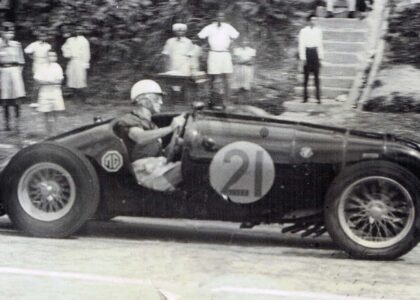
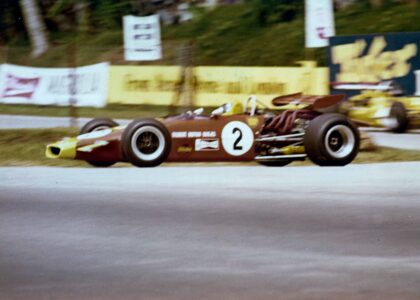
One thought on “RIDES OF MARCH – Part 1”